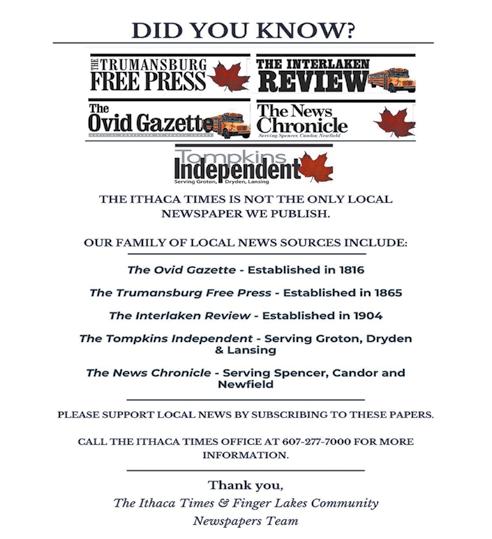




Throughout the month of October, the color pink transforms into a universal symbol for women’s health and breast cancer awareness. The annual tradition of wearing a pink ribbon is a way to show support for breast cancer survivors, remember those lost to the disease, and promote early detection and research.
Early signs of breast cancer can manifest in the form of physical symptoms. Some breast changes can be felt and seen in the form of a new or thickening lump, changes in size or shape, skin dimpling that resembles an orange peel, redness, swelling, nipple inversion, nipple discharge, and pain in the breast or nipple. Sometimes people don’t experience any symptoms at all. Cancerous masses that linger deep in the breast tissue can only be detected with a mammogram.
The breast is made of milk glands, milk ducts, fatty tissue and supportive tissue, all of which is compressed for more accurate imaging during a mammogram. For certain types of breasts, mammograms can be difficult to interpret. This is because there is a wide variation in breast tissue density among women. Denser breasts are more difficult to assess for tumor diagnosis.
“Sometimes, your normal anatomy can make images look a little suspicious and they may want to take a closer look. It’s not always a terrible thing to have to be called back. That’s something patients get scared about. Sometimes it makes them feel better when we say we just want to get a closer look at what’s going on,” says Heather Fay, Computed Tomography (CT) technologist at Arnot Health, a member of Centralus Health.
Newer machines, like Digital Breast Tomosynthesis (3D mammography), give radiologists a clearer, more detailed view of the breast, increasing the detection rate of cancers. A 3D mammogram uses an X-ray arm to take multiple images of breast tissue in thin slices, allowing radiologists to view the tissue in a 3D format and improve cancer detection, especially in dense breasts. A traditional 2D mammogram creates a single, flat image, which can make it harder to see through dense tissue and detect abnormalities. The ability to see through overlapping layers of breast tissue in 3D allows radiologists to detect cancers that might be hidden in a 2D mammogram. Studies show 3D mammography can detect cancers that would have been missed with 2D alone.
“It actually gives less radiation the more we compress your breast,” says Heather.
The compression is what most women associate with discomfort, though it is vital in minimizing motion blur, enhancing clarity, and lowering the amount of radiation needed.
“Compression is important, but we always work with the patient. If it starts to feel uncomfortable, we tell them to let us know and we do what we can to make it easier,” Heather says.
The elegant design of 3D mammography equipment is more than just aesthetic; the gentle, rounded corners of the image receptor, where patients place the breasts, completely changes the experience compared to the traditional mammogram. Heather says this design forms much better to the patient’s body and doesn’t jab them as much.
Radiologists and technologists understand the anxiety associated with waiting for imaging results. At Centralus Health, mammograms are typically read within a day or two of an appointment.
“Our radiologists are very quick about it. We don’t like to have a lot of time in between; we like to get the results to patients as quickly as possible.”


Digital Breast Tomosynthesis (3D mammography) gives radiologists a clearer, more detailed view of the breast, increasing the detection rate of cancers.
For most women, routine mammograms should begin around the age of 40. Women with higher-than-average risk for breast cancer, such as those with a family history or genetic mutations, should consult with their healthcare provider about starting earlier. Family history includes any immediate family such as mothers, grandmothers, or aunts. If you do have family history, providers recommend beginning mammograms at 35, and will determine if you need to come back every year or every two years.
Cayuga Health offers 3D mammography at their main campus location, 101 Dates Drive, Ithaca, (607) 274-4376; East Campus location, 10 Arrowwood Drive, Ithaca, (607) 274-4155; Cayuga Park location, 401 Cayuga Park Lane, 4th Floor, Ithaca; Schuyler Hospital, 220 Steuben Street, Montour Falls, (607) 535-7121; and in Cortland, 1081 Commons Avenue.
Arnot Health offers 3D mammography at the Horseheads Medical Office Building, 100 John Roemmelt Drive, (607) 739-0352; and the Health Center for Women, 600 Fitch Street, Elmira, (607) 795-8080.
By Philip O’Dell
City Manager Deb Mohlenhoff presented her proposed 2026 city budget to the Ithaca Common Council on Oct. 6. Mohlenhoff described the budget as a “cost of doing business” plan that maintains all current programs and services while remaining under the tax cap.
Deputy City Manager Dominick Recckio said the city’s largest revenue source, the property tax levy, is a proposed $34,573,882 for 2026, a 3.5% increase from 2025.
Introduced by former Gov. Andrew Cuomo and passed in 2011, the New York State Property Tax Cap limited the increase of property taxes levied by local governments and school districts by 2% annually or at the rate of inflation. In recent years, the tax cap has been calculated by taxing entities to be above 2% due to the rising consumer price index (CPI).
For homeowners, the proposed increase is estimated to raise the tax bill on a median-valued home of $350,000 by $81, a 1.9% increase city officials say is driven by new construction and home improvements. In the city of Ithaca, 58% of property value is tax-exempt.
“Our role is to be good stewards of these funds while being an effective government that delivers for residents,” Recckio said.
Mohlenhoff said the proposed budget essentially allocates city departments the same operational funding they received in 2025. Her office requested departments to submit only “absolutely necessary” expenses above targeted requests and led to departmental cuts and absorbed costs.
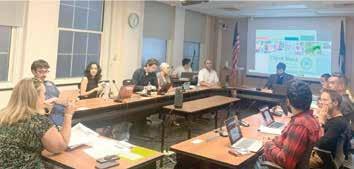
Mohlenhoff said this budget approach is not sustainable long-term. She said the city must address how this will impact budgets beyond 2026. She warned that future years may necessitate “tougher conversations down the road” on public services, finding ways to diversify revenue streams, or exceeding the state’s property tax cap.
“We may have done everything that we possibly could for 2026, but we need to kind of move forward together strategically to think about what that would look like beyond 2026,” Mohlenhoff said.
Mohlenhoff’s proposed budget includes a total of $112,893,913, a $6.1 million increase from the 2025 budget. The largest proposed growth is in the general fund set at $90,563,757—a $5.4 million
increase. It also includes the sewer fund at of $9,855,240 ($723,606 increase), water fund at $9,086,902 ($472,619 increase), solid waste at $730,917 ($30,592 increase), sidewalk district at $1,162,898 ($8,506 increase). The stormwater fund would be $1,494,199, a decrease of $186,690. There is a proposed 19% increase to sewer rates due to the rising expense of running the city’s aging wastewater treatment facility and the need for essential infrastructure updates, Mohlenhoff said. The minimum quarterly water bill will increase to $17.76 per quarter or $71.04 annually, driven by the cost of infrastructure work at aging water facilities, higher costs for treatment chemicals, and increased landfill and disposal fees. Trash tags will
Continued on Page 5
CORRECTION: In the September 24 issue of the Ithaca Times, the Page 19 story about Ithaca College’s Men’s Basketball Season was written by Arnau Phillips Villa, not Steve Lawrence. The Times regrets this byline error.
X Thirteenth Annual Finger Lakes Crossword Competition Returns to Ithaca on Oct. 18 ITHACA, N.Y. — The Thirteenth Annual Finger Lakes Crossword Competition will be held Saturday, Oct. 18, from 1 to 4 p.m. at Boynton Middle School in Ithaca.
The event serves as a fundraiser for Tompkins Learning Partners, a nonprofit that provides free literacy tutoring for more than 100 adults in the community. All proceeds directly support adult literacy programs in Tompkins County.
The competition is open to individual participants and teams of two to four players. Competitors can choose among three difficulty levels based on New York Times crosswords. Each individual or team will be given a puzzle at their selected difficulty level, and winners will be determined by the fastest completion times with perfect scores. Prizes will be awarded to the top three individuals and teams who complete perfect puzzles in the shortest time. Each winner will receive
a certificate, a Merl Reagle crossword book, and the FLCC Championship Bracelet, a unique symbol of achievement for Finger Lakes puzzlers. Doors open at 1 p.m. for registration, check-in, and refreshments. Competition play begins at 2 p.m. and concludes at 3 p.m., followed by judging and awards at 3:15 p.m. Virtual participation is available for those unable to attend in person, though prizes are reserved for inperson winners.
Registration is on a sliding-scale basis, with a suggested fee of $50 per player, but participants are encouraged to pay what they can comfortably afford. Online registration closes at 9 p.m. on Friday, Oct. 17, and on-site registration will be available until 1:30 p.m. on the day of the event.
For more information, including registration, sample puzzles, and competition rules, visit CrosswordCompetition.com or email event chairperson Gary Weissbrot at CrosswordCompetition@hotmail.com.
Six candidates are vying for three seats on the Tompkins County Legislature in this year’s contested races. (Design: Kaiden Chandler/Ithaca Times
F r EE lanc E rs : Barbara Adams, G. M Burns, Charley Githler, Stephen Burke, Bill Chaisson, Ross Haarstad, Steve Lawrence, Marjorie Olds, Henry Stark, Peter Rothbart, Austin Lamb, Clement Obropta, and Jake Sexton
THE ENTIRE CONTENTS OF THE ITHACA TIMES ARE COPYRIGHT © 2025 BY PATHWAYS TO EQUITY, LLC. All rights reserved. Events are listed free of charge in TimesTable. All copy must be received by Friday at noon. The Ithaca Times is available free of charge from various locations around Ithaca. Additional copies may be purchased from the Ithaca Times offices for $1. SUBSCRIPTIONS: $139 one year. Include check or money order and mail to the Ithaca Times, PO Box 27, Ithaca, NY 14851. ADVERTISING: Deadlines are Monday 5 p.m. for display, Tuesday at noon for classified. Advertisers should check their ad on publication. The Ithaca Times will not be liable for failure to publish an ad, for typographical error, or errors in publication except to the extent of the cost of the space in which the actual error appeared in the first insertion. The publisher reserves the right to refuse advertising for any reason and to alter advertising copy or graphics deemed unacceptable for publication. The Ithaca Times is published weekly Wednesday mornings. Offices are located at 109 N. Cayuga Street, Ithaca, NY 14850 607-277-7000, FAX 607277-1012, MAILING ADDRESS is PO
By Mark Syvertson
“INQUIRING MINDS WANT TO KNOW: WHO’S A GOOD DOG”?
NOTE: If readers wish to participate in the Ithaca Times’ Inquiring Photographer column, contact Mark Syvertson at marksyvertsonphotography@gmail.com





By Lorien Tyne
In June, New York State Electric & Gas (NYSEG) filed a request with the New York State Public Service Commission (PSC) to increase the cost of its delivery rates. PSC is now undergoing a rate case, a formal process to determine if PSC will approve or modify NYSEG’s request, which includes public hearings and other opportunities for community input.
NYSEG is looking to increase delivery rates by 35% for electricity customers and 39.4% for natural gas customers. If approved, monthly bills are estimated to increase by about $33 for typical residential customers using 600 kilowatt-hours or 83 therms. NYSEG provides service to more than 40% of upstate New York, including Tompkins County.
NYSEG and Rochester Gas and Electric Corporation both filed requests on June 30 to increase their annual electric and gas delivery revenues for the 12-month period ending April 30, 2027. As a result, PSC has four open rate cases: two for each company concerning gas and electricity delivery costs separately.
This new rate hike request came not long after NYSEG’s last rate hike completed its final phase of implementation in May. In 2023, PSC approved NYSEG’s request for its delivery rates to increase by 62% for electricity and 17.8% for gas over three years.
As previously reported by the Ithaca Times, upstate New Yorkers are becoming increasingly frustrated with the consistent rate hikes and lagging quality of service. Residents’ discontent is also apparent in more than 1,500 public comments regarding NYSEG’s rate case on PSC’s Document Matter Management system.
During a rate case, the utility company — NYSEG in this case — must provide an explanation of why the increase in delivery cost is needed along with details about its costs and future plans. NYSEG argued that the rate hike is needed to “support investments to meet growing energy demand across New York and to upgrade aging infrastructure and systems to improve reliability and customer service,” according to PSC.
Regarding the electric delivery rate hike

request, NYSEG stated that the primary reasoning is due to increased storm and vegetation management expense, increased capital investments to address aging infrastructure and to increase capacity, information technology upgrades, and incremental operations and maintenance expense.
Regarding the gas delivery rate hike request, NYSEG stated the primary reasoning is due to wage requirements, federal and state pipeline safety mandates requiring system investments and upgrades, and costs to meet clean energy goals.
Elected officials, municipalities, ratepayers and other interested parties can participate in a rate case by submitting evidence and arguments against the utility company’s request. One way the PSC is gathering community feedback on the proposed NYSEG rate changes is through upcoming public hearings. A press release from Tompkins County detailed how residents can participate and said that public input will help inform the PSC’s decision.
Senator Lea Webb and Assemblywoman Donna Lupardo also released a statement encouraging New Yorkers to provide feedback on NYSEG’s proposed double-digit rate increase.
“I urge ratepayers to make their voices heard during the public comment period,”
Webb stated. “This is an important opportunity for the public to voice their concerns on the record to make sure the PSC understands the effect that any further increase would have on their livelihoods. Families and small businesses across Upstate New York are struggling to pay high utility bills and cannot afford another double-digit rate hike. I will continue to fight for measures to cut costs for residents and instill greater oversight in the rate setting process.”
The in-person hearings nearby are scheduled for Wednesday, Oct. 8 at 1 p.m. and 6 p.m. at Ithaca Town Hall, 215 North Tioga Street. No pre-registration is required for in-person hearings but if attendees wish to speak they will need to sign in and complete a request card upon arriving.
Virtual hearings are scheduled for Tuesday, Oct. 21 at 1 p.m. and 6 p.m. To attend the virtual hearings, advance registration is required by Oct. 17 and is available on the PSC’s Public Hearing Calendar. Individuals can also join the Webex livestream or dial in by phone at (929) 251-9612 with the access code posted on the calendar.
Community members do not need to attend a public hearing to provide input. Written comments can be submitted online through the PSC’s Document Matter Management system under NYSEG’s rate case docket numbers: 25-E-0375 for electricity and 25-G-0378 for gas.
By Philip O’Dell
Afinalized agreement could signal a major shift in how Tompkins County approaches long-term staff retention and its status as a competitive employer.
The Tompkins County Legislature approved a four-year agreement for the Tompkins County Corrections Officers Association (TCCOA) on Sept. 16, taking effect on Jan. 1, 2026.
“Corrections officers perform one of the toughest jobs in public service,” county legislator and Public Safety Committee chair Rich John said. “With this contract, the legislature is sending a clear message: we respect their
work, and we are prepared to invest in keeping Tompkins County a safe place for all.”
The new contract boosts the starting annual salary for an officer in 2026 to $60,700, ultimately reaching $67,200 by 2029.
Tompkins County Sheriff Derek Osborne said the agreement will support long-term staff retention and maintain the county’s competitive employer status. He said the county has maintained staffing levels successfully with many correctional facilities across New York state facing such challenges.
“Our Corrections Division makes up the largest staffing group within our office,” Osborne said. “Their work is often challenging, demanding, and underrecognized.
This contract reflects our appreciation for their service and ensures that their dedication to our community is properly valued.”
The agreement also raises pay significantly for veteran employees, with officers having 15 to 20 years of service seeing their annual earnings grow from $74,400 to over $82,400 during the same period.
“This agreement demonstrates Tompkins County’s commitment to valuing and supporting the people who provide critical public safety services,” County Administrator Korsah Akumfi said. “By strengthening pay and benefits for our corrections officers, we are ensuring stability for our workforce and security for our community.”
By Lorien Tyne and Maddy Vogel
The Tompkins County Sheriff's Office and the Ithaca Police Department are alerting the community that threatening emails were sent to several organizations and individuals on Monday.
The report stated that the threatening emails were sent to several local schools in Tompkins County, which also contained threats directed at county employees, elected officials and local financial institutions.
The Sheriff’s Office is investigating the threats with assistance from other local law enforcement and the Federal Bureau of Investigation (FBI). As a safety measure, extra security is being implemented at local schools and for the individuals named in the email threats.
increase to $1 per tag. She said there are no proposed changes to the rates for sidewalk, yard waste, or stormwater fees. Personnel costs consist of 75% of the budget. While labor costs are becoming more predictable under current contracts, significant pressure comes from fringe benefits, which are fixed costs the city must absorb, Mohlenhoff said. Major fringe benefit increases include employee health insurance, with the city’s share rising to 18%, making it the largest fringe
“Our top priority is the safety of our students, educators, and community members,” said Sheriff Derek Osborne in the press release. “We are maintaining open communication with our school districts and law enforcement partners as this situation develops.”
The Dryden, Newfield and Lansing school districts all conducted a lockout for varying times on Monday until law enforcement determined there was no active threat to school safety, according to reporting from 14850.com.
The sheriff’s press release also mentioned that similar threats have been reported in other New York counties.
This series of email threats comes not long after four superintendents in Tompkins County at Lansing, Ithaca, Dryden and Tompkins Seneca Tioga BOCES received an email threat Sept. 26 indicating
cost. For retirement, the cost for the New York State and Local Retirement System (NYSLRS) will increase from 16.5% to 17.6% of payroll, and state retirement costs for police and fire will rise from 33.7% to 36.5% of payroll. She said personnel and fringe benefits are fixed costs that the city has limited control over, meaning the administration typically must absorb the largest increases in fringe expenses. In a continued austerity effort, the general fund budget is earmarking $9.6 million for debt payment in 2026, slightly more than the $9.5 million paid off in 2025. The living wage increases for employees

New Roots Charter School in Ithaca has expanded to include a Montessoriinspired middle school program for grades 6-8, adding 50 students this fall as part of its 2025 charter renewal.

The federal government shutdown is threatening to disrupt vital nutrition programs like SNAP and WIC, putting millions of New York women and children at risk of hunger. Advocates warn the lapse in funding could worsen the state’s hunger crisis, with families already going into debt to afford rising food costs.

a potential school shooting at an unspecified school in the county. The threat was deemed non-credible but additional safety measures were implemented.
In the Ithaca Police Department’s Monday statement, it said the threats received this week were similar to the threats to the community in recent weeks.
“The Ithaca Police Department takes all threats, and the safety of our community extremely seriously and actively investigates each threat that is reported to us,” said Captain Ted Schwartz. “The threat received today is currently under active investigation in conjunction with our partner agencies at the local, state and federal level of law enforcement, as well as with the people and entities with whom the threat was directed.”
The department stated that more information would be released as it becomes available.
making below the 2026 living wage resulted in a $217,000 additional cost absorbed into payroll and fringe lines across departments. Mohlenhoff suggested the city pursue preparative actions, such as capital and five-year planning or strategic long-term thinking to ensure future financial stability.
The city would not use its fund balance to support the 2026 budget, having spent $3 million on the 2025 budget. The city’s unaudited fund balance, a measure of accumulated operating surpluses, is estimated between $13.5 million and $14 million.

The Annual Trumansburg Senior Citizens Bazaar will be held on Saturday, October 18, from 9 a.m. until 1 p.m. at the Trumansburg American Legion, corner of Route. 96 and Seneca Rd. A Luncheon with soup, sandwiches (including pulled pork) will be held from 11 a.m. To 1 p.m. Vendors will also be selling homemade baked goods, crafts and recycled jewelry.
New York Attorney General Letitia James joined 11 other attorneys general Tuesday in suing the Department of Homeland Security, accusing the agency of unlawfully withholding hundreds of millions in public safety funds. The lawsuit claims FEMA has diverted money from states that refused to back the administration’s deportation policies, cutting grants for law enforcement training, emergency preparedness and counterterrorism.
IF YOU CARE TO RESPOND to something in this column, or suggest your own praise or blame, write editor@ithacatimes. com, with a subject head “U&D.”
Do you think we need experienced members or fresh perspectives on the Tompkins County legislature? 38.2% New voices.
Experienced members. 16.4% I don’t care.

Should the Public Service Commission approve NYSEG’s request to increase delivery rates for customers in upstate New York? Visit ithaca.com to submit your response.
$1.2 Million in New Requests Tests City’s Fiscal Priorities
“Every budget season, our city faces more needs than dollars. This year, two proposals highlight that challenge. The first is a request for over $500,000 in additional city funding to sustain TCAT, our public transportation system. For many—students, workers, seniors, and those without cars—public transit is a lifeline. The second is a proposal for a new team of unarmed responders to handle nonviolent 911 calls, designed to reduce interactions between Black residents and police. I support the concept, but it carries an annual cost of more than $700,000. Together, these asks exceed $1.2 million in new, ongoing expenses. Even with some encumbered funds to help launch the unarmed response program, both initiatives will still require substantial new dollars this year—and likely the same or more in future budgets. Starting a program is not the same as proving we can sustain it.
I support the values behind both proposals. But I do not believe it is fiscally responsible to add two large expenses in the same year without offsets. Unless we make choices, we risk cuts elsewhere or higher costs for residents already struggling with rising expenses.
Budgets are about priorities. This year, we must either commit to funding one of these proposals and revisit the other next year, or identify cuts that allow us to responsibly support both. Our community deserves sustainability as well as vision.” — David Shapiro, Third Ward Alderperson, Ithaca Common Council
“Almost a year ago the news got out that PRI was on the verge of closing, due to the disappearance of support from a major donor. Three million dollars were due by the end of 2025 to avoid foreclosure on both PRI and the Museum of the Earth, and the situation looked hopeless. Thanks to two donations, each of $1 million, and of significant other smaller donations, there now seems to be light at the end of the tunnel, but only just. Negotiations with the mortgage holder to determine whether an amount smaller than $3 million would suffice failed. Moreover, PRI is paying interest on this debt (at 13%), which is over $30k/ month. With only three months left before the foreclosure date and with the finish line

in sight, every effort is and must be made to satisfy the creditors. At this stage help, in any amount, is desperately needed. If the mortgage isn’t paid off, future plans are moot because PRI and the Museum will cease to exist. In that case the local community and scientific world at large will lose an incredible resource. I’m a member of the Board of Trustees and can be contacted for further information at dek9@cornell.edu.”
— Dan Karig, Cornell University Board of Trustees
“One of Dryden’s great strengths is the caliber of our local leaders. Among them is Dan Wakeman—Deputy Mayor, longtime public servant, and now candidate for County Legislator.
Dan has spent 14 years serving on village committees and as an elected official helped secure $17.4 million for infrastructure, housing, economic development, and public safety.
Dryden needs his proven leadership at
continued from page 5
Mohlenhoff said the city’s financial audits from 2022 to 2024 must be completed before officials can calculate the fund balance and adjust and leverage savings in future budgets.
The budget introduces a vacancy rate adjustment, a financial tool that projects around $1 million in savings based on anticipated turnover. It also reflects expected salary and benefit savings from
the county level. Our democracy depends on electing people like Dan. Please join me in voting for him in this all-important November election—let’s stand with Dan!” — Dave Vollenweider, Dryden NY
“Now more than ever we should pay close attention to who’s representing us on the County Legislature. Here’s some good news. Dan Wakeman, currently the Deputy Mayor of Dryden Village, is running to fill the position left open by Mike Lane’s retirement. Democracy is at its best when excellent people like Dan, a long-term resident of Dryden and a civic leader, step forward. Stand with Dan and don’t sit out the November election. Dan has been a hard-working councilman in Dryden for over a decade and knows the ropes of leadership. Dryden has him to thank for helping to secure $17.4 million in grants for infrastructure, housing, and economic development. Let’s elect Dan in November and reap the rewards of a smart leader with technologybusiness background, and a proven record of civic action.” — Charles Geisler, Ithaca NY
normal staff turnover and hiring delays. Mohlenhoff will pilot this new program with a monthly report to ensure the actual vacancy rate, which is currently 11.5%, or 50-55 vacant positions of around 480 fulltime staff.
Mayor Robert Cantelmo said there will be public budget hearings on Oct. 8, Oct. 15, and Nov. 5. The council plans to adopt the budget at the final hearing. Cantelmo told council members to submit any budget amendments by Oct. 17 so the city has time to collate them and respond.
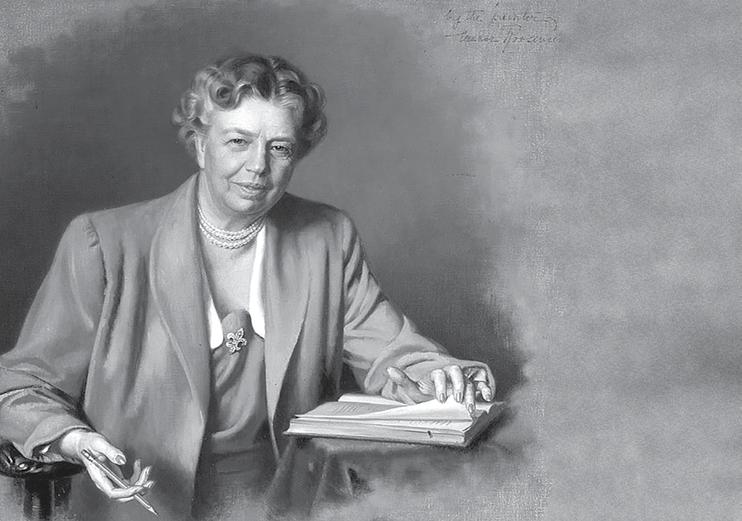
“Do what you feel in your heart to be right, for you’ll be criticized anyway.”
— Eleanor Roosevelt
By Roy Allen
When the Founding Fathers penned the Declaration of Independence, they enshrined three unalienable rights as the foundation of the American promise: life, liberty, and the pursuit of happiness. More than two centuries later, most Americans can reasonably say they’ve secured the first two. We enjoy protection under the law, access to education and personal freedoms that many in the world still fight for. But the third right—the pursuit of happiness—remains elusive for many. Despite material comforts, technological convenience, and unprecedented choice, millions still struggle to find meaning in their daily lives. Several years ago, the US Department of Labor reported that over 70% of the workforce was disengaged, meaning that they found little purpose or value in their jobs beyond earning a paycheck. Their struggle points to a deeper need: the search not just for happiness, but for purpose.
In modern America—at the cusp of technological revolution, social transformation, and global interconnection—the pursuit of a purposeful life has taken on new dimensions. As we peer into the nation’s future, the challenge and opportunity lie in aligning personal meaning with the broader arc of national progress. A purposeful life is no longer just a personal ideal—it is a necessary building block for the future of America.
Historically, the American Dream has been framed around tangible success: upward mobility, homeownership, a secure job. These markers served well in a growing economy and post-war society. But in today’s rapidly shifting world, many are questioning whether those measures alone fulfill the promise of happiness. Younger generations, in particular, are reimagining what it means to live well—not just to have, but to be: to be useful, to be connected, to be fulfilled.
A purposeful life begins with asking hard questions: Who am I beyond my profession? What do I value? How do my actions shape the world around me? These questions may seem individualistic, but when embraced on a societal level, they become a catalyst for national renewal. Imagine a country where its citizens—educators, engineers, artists,

and leaders alike—are guided not just by ambition but by a sense of responsibility and service. This is not idealistic fantasy; it is a necessary evolution.
America’s future depends not only on economic growth or technological prowess, but on moral clarity and shared purpose. As we face pressing challenges—climate change, political polarization, racial injustice, and economic inequality—it is clear that the old paradigms of power and profit are insufficient. We need citizens and leaders with the courage to care, to think long-term, and to build systems rooted in equity and sustainability. Purpose-driven innovation is already shaping the future. Social entrepreneurs are creating businesses that balance profit with impact. Scientists are working to combat disease and environmental degradation with a sense of service to humanity. Educators are reshaping classrooms to cultivate critical thinking, empathy, and civic responsibility. These efforts show that when purpose is at the center, progress is not only possible—it becomes inevitable.
One of the greatest opportunities for America lies in redefining education as a platform for purpose. Rather than training students solely for the workforce, we must prepare them for lives of meaningful contribution. This means fostering curiosity, resilience, creativity, and ethical reasoning. Schools should be places where students not only learn facts, but explore who they are and how they want to serve the world. A generation raised with this mindset could redefine what leadership looks like in the 21st century. Technology, too, must be harnessed with purpose. Artificial intelligence, biotechnology, and clean energy innovations will undoubtedly shape America’s future. But without a moral compass, these tools can deepen inequality and erode trust. We must therefore ask not just what we can build, but why—and for whom. The future belongs to those who can align innovation with human values. Furthermore, a purposeful life must be rooted in community. Individual fulfillment cannot come at the expense of our neighbor’s well-being. America’s
By Austin Lamb
Like many people, Arthur Whitman said he’s online “all the time.” He’s aware of how social media disrupts our attention spans, conditioning users to quickly consume content. As an art critic for the Ithaca Times, and an artist himself, Whitman sees a role for art in helping a viewer slow down and retrain their focus.
“I think there’s something to be said for walking into a gallery or a museum and spending some time with a handmade object,” he said. “I think that's absolutely something important.”
An Ithaca native, Whitman graduated from Ithaca High School in 1998. He attended The School of the Museum of Fine Arts in Boston, graduating in 2003 with bachelor of fine arts degree in visual arts. When Whitman returned to Ithaca in the fall of 2005, he’d begun moving away from making visual art. Painting and drawing required physical space to work in, energy to produce, and could leave a lot to clean up. A year later, he joined the Ithaca Times as an art critic.
“I was looking for a way that I could be involved with the visual arts and a way that I could be involved with the arts community here in Ithaca,” he said. “I sort of knocked on the door at the Ithaca Times, and eventually they let me start writing for them.”
Whitman said his formative artistic influences include Paul Klee, Paul Cézanne, Henri Matisse, Jackson Pollock, and Willem de Kooning. He’s also educated himself about “everything from the cave artists to a broad range of contemporary art,” he said. Whitman travels to New York City often, where he likes to visit the Chelsea Gallery District, The Museum of Modern Art, and The Metropolitan Museum of Art, among other museums and galleries.
Whitman sees art criticism as a form combining the informational aspects of journalism with the personal insight of opinion writing. While his ideal reader, he said, has some familiarity with the visual arts, he’s also conscious of translating his expertise in his art when writing for a general audience.

Whitman varies his approach to writing a review according to the artistic work and its creator. For local artists who don’t have as much of a track record, he said he prioritizes responding just to the work or exhibit itself. When he writes about established artists, he said, there’s a responsibility to respond to the artist and their body of work as well. “You do want to give people a sense of who the artist is, where they’re coming from, where they’re going with their work,” he said.
Regardless, Whitman always tries to describe the work of art, and the rest of a review comes from that, he said. “It’s always good to contextualize the work in terms of contemporary art, historical art,” he said.
A decade ago, Whitman curated his first exhibit at the Community School of Music and Arts. And although Ithaca’s art scene can be a “mixed bag,” Whitman said, he appreciates what the area has to offer for a city of its size.
“I know a lot of artists and I’m always meeting new artists,” he said. “In terms of the number of active artists, the number of galleries, the number of exhibits, [...] there’s definitely a lot going on.”
By Stephen Burke
It wasn’t because our work friend L. got hit by a car while biking to the job. That didn’t happen until some weeks later.
Work is downtown, and a few of the staff bike to work regularly.
D. is among them. She lives in Fall Creek. She knows that I am an occasional biker, because I have chided her for not wearing a helmet. She knows she should, she said, but doesn’t like the look.
“I know, it makes you feel like Gazoo from the Flintstones,” I said, in obscure cultural reference to a space alien cartoon character with a small body and big helmet-covered head. “But you look smart in it, not like someone courting brain injury. The look that makes me cringe is when I see someone riding without one.”
Recently, going home from work, she stopped to show me her new helmet. She wears it regularly now.
Sometimes it just takes time to get used to the idea and the look. Sometimes it happens after a close call.
It was still some weeks before my work colleague got hit when I was talking with some bike-riding friends about our habits and experiences. Despite my advocacy for riding, I said, I had purposely cut back on it in instances when I could walk instead, for safety reasons.
Surveys by Bike Walk Tompkins, a resource group in Tompkins County, say that about 15% of bike riders here report having had “a crash or close call” with a motor vehicle. The figure would go up considerably, no doubt, if it included accidents or near-accidents due to bad roads.
I’ve had both. I use my bike a lot for trips in town: to the bank, gym, library, shopping, etc.
Anyone who does probably has lost count of the number of times they were almost hit by a driver pulling out of a parking space who was, at most, looking for other cars. Probably at least unconsciously the car driver is only concerned with other cars, which can damage theirs, while a bike can’t, or not much. A car will win a battle with a bike.
Most bike riders have probably also experienced this careless or aggressive attitude in right-of-way situations with a car.

For instance, if you are biking into Wegman’s parking lot from South Street, going straight in with the right-of-way at a green light, beware of cars coming out making a left onto Route 13. They are supposed to yield to you, but chances are they will cut you off, their road rage already simmering with the long line out of Wegman’s and the light that might, horribly, change on them. The middle of four lane (six, with turning lanes) Route 13 is a terrible place for a biker to have to screech to a stop, but be ready.
When biking I wear a big police whistle around my neck and already in my mouth so I needn’t waste a second to sound it when suddenly in a dangerous situation. Those big ceramic whistles make a loud noise that can scare people into stopping.
My decision to reduce bike use for walking, when time is not an issue, came not from a close call with a car, but with a hidden pothole.
I was biking down a street a few hours after a big rain. I needed to make a right at a corner up ahead where I could see a big puddle. I figured I’d ride through it and get a little wet rather than veer any further to my left into the lane to avoid it, possibly alarming other traffic.
A noble impulse, but a big mistake, as I didn’t realize the big puddle was covering a big pothole. I rode right into it and lost control of the bike. I managed to land on the sidewalk, not in the street.
It wasn’t too bad, just cut me up a bit.
But it happened after a recent near-miss with a car, and I decided I was through dodging the odds on a bike, at least for now, at least for short distances when I can walk as conveniently, though of course not as quickly.
All this happened before our colleague got hit by a car while biking to work. We heard from a witness he went over the hood, but have also heard he is all right.
We don’t have any answers for all this, but hopefully awareness will encourage bikers to think of their safety and act accordingly, like our work friend now in her helmet, and car drivers to slow down and think of driving as something to do coolly and carefully, not as a race or battle.
Away,
By Mike Sigler, Tompkins County Legislator
When a data center was first talked about more than five years ago at the former power plant in Lansing there were a lot of questions, but in the end most, including the state of New York under it’s Climate Leadership and Community Protection Act, supported the change.
The town of Lansing is now considering a moratorium that could block this development, and a lot of other development in the town. The moratorium angered many in the town because of the short notice, only three full business days, before the public hearing on it was held, and that while the notice was in the Ithaca Journal, required by law, and was on the town website, not many read the Journal, and it was buried under two clicks at the website.
Most residents concerns center around protecting Cayuga Lake and electricity prices. The center says it will not use the water intake at the plant and will not discharge water into the lake. They will use the same setup they have at their center in Somerset. The reason this site is being planned for is the substation and hightension powerlines and interconnect to the grid. You can see their cooling system here: https://www.youtube.com/watch?v= T5nfF4dFTUo&feature=youtu.be
Electricity costs have everyone worried after massive rate hikes by NYSEG. It’s my understanding from out Congressman, State Senator and Assemblywoman among others, that it’s delivery under NYSEG driving these cost increases, which explains the pushback against the Public Service Commission, and not supply cost increases. However, it’s a concern with any industrial use like Micron going into Central New York or industrial uses like electric steel foundries or plastic molding factories going in. In a recent article Crypto currency was a focus. This plant says that it will not be mining cryptocurrency which should quiet another concern.
My understanding is that so much industry has left Upstate NY that there is now a surplus of electricity Upstate. You really need to break New York State apart when talking about this because that is not the case in NYC. It’s hard to predict,
but I’ve suggested the company set up a fund that if Lansing sees an increase in supply price, that fund could send refund checks to ratepayers. Is that possible? I’ve put it on the table. While this should be looked at, are we saying that there should be no new large industry in Upstate NY because it would decrease electricity supply? I don’t think we’re saying that. It's been suggested that electricity in NY should only go to power “communities.” Are data center’s not part of communities? Some may not like them, but the genie is out of the bottle. There are more than 5200 data centers in the US. NYS is offering scholarships to study AI. For coal fired powerplants like this one, data centers were a recommended use in the CLCPA for retired coal fired powerplants. 500 union workers would be used to build the plant. Members of our community. 100 mostly union workers will run the center. Again, members of the community. Like the power plant workers before them, they are our volunteer firefighters, coaches, and Rotarians. Cornell is also highly invested in AI with a “university wide radical initiative.” https://www.hesc.ny.gov/about/newsreleases/governor-hochul-announces-firsttheir-kind-ai-specialized-degrees-offered https://ai.cornell.edu/
Some question if a moratorium is even legal. The town argues it’s about rezoning after the comprehensive plan passed. But that was seven years ago. From past comments from the town attorney, I’m not sure it’s legal to put this moratorium in place: https://www.ithaca.com/news/lansing/is-ittoo-early-to-talk-moratorium/article_dbce 17f6-81bf-11eb-b48a-6b0012a97930.html
It was very clear from the public meeting that most, both for and against, believe this is targeted at the AI center. The town attorney was on vacation during the initial call for a public hearing and for the public hearing. The head of planning was also not there.
The suggested moratorium opens the question for what industry would be acceptable in Lansing? The power plant eventually wasn’t. It could be argued that closure raised electricity prices too, but

By Philip O’Dell

Economic growth and a living wage took center stage at the Sept. 29 “Meet the Candidates” event at Tompkins County Public Library, featuring over a dozen candidates vying for seats on the Tompkins County Legislature.
The event was sponsored by the Tompkins Chamber, Community Foundation of Tompkins County and the Ithaca Board of Realtors.
After redistricting, the county legislature now consists of 16 seats across 16 legislative districts, an increase of two seats from the previous 14-district structure. The new maps were drawn after the 2020 census and took effect in January 2025.
Three contested races include District 8 (formerly District 6) with four-term Republican incumbent Mike Sigler against Democrat Jamie Perkins, District 10 (formerly District 14) with Democrat Dan Wakeman facing Independent Thomas Corey, and District 14 with Democrat Christy Bianconi against Independent Michelle Wright.
MIKE SIGLER, DISTRICT 8
REPUBLICAN NOMINEE
Sigler said economic growth is driven by focusing on existing businesses while attracting new ones, stating jobs create com-
munities because workers often become volunteers and engage with other residents. According to Sigler, the county tax levy will always increase due to contracted salaries and unfunded state mandates. He said taxes will go up unless massive cuts are made. Concerning a living wage, Sigler questioned if every job needs to pay one. Instead, he encouraged more development to ensure infrastructure is site-ready to attract businesses that pay living wages.
Perkins did not attend, although he provided written statements. Perkins said he would focus on tourism to increase sales tax to alleviate tax burden on residents. He would contact local, state and federal officials for tax incentives or support programs for businesses that commit to paying fair wages. He seeks to form partnerships between business and local nonprofits. Regarding cooperation, he would create a formal meeting place with county and local leaders to identify and prioritize shared goals and services.
Wakeman said economic development helps businesses grow and increase prop-
erty values, adding that fostering housing development is crucial. As an example, he said Tompkins Cortland Community College (TC3) sold one of its apartments in his district, which he expects will transition to private ownership, leading to increased housing and property value, and thereby boost the tax base. He highlighted TC3’s Reconnect Program that provides free associate degrees for eligible adult learners in high-demand fields as a good local source of economic development. Regarding the living wage, Wakeman suggested focusing on affordability rather than increasing pay, though he noted that while he was on the Dryden Village Board during COVID-19, it saved on turnover costs by approving a pay increase to offset inflation.
Corey described himself as a Bull Moose candidate from Dryden and said Tompkins County spends too much and doesn’t need more resources, citing an increase in the county’s employee base from roughly 600 in the 1990s to about 800 currently. He called for a hold on the proposed $50 million, 50,000-square-foot Center for Government project, asserting that a similar facility could be acquired or leased for half the cost. Corey also said Cornell
University should partner in county activities, given it represents about 30% of the county population. Corey described a county minimum wage as a “foolish performative act,” arguing it would increase the cost of living and hinder business formation, though he supports “people being paid what they want.”
Bianconi expressed concerns on rising property taxes, which she noted have increased over 20% on her own home in five years. To alleviate this, she advocated for increasing sales tax and leveraging the student population of around 35,000 by creating student discount cards and a “restaurant week” to encourage local spending. Bianconi said while affordability is a concern, causing friends and family to leave the area, the county should promote efforts of certified living wage employers and build upon existing services. She called for more support for the Tompkins County Council of Governments (TCCOG), which coordinates housing, infrastructure, and climate efforts across local municipalities. She said data-sharing by local governments can increase efficiency and establish a united front to obtain grants.
INDEPENDENT NOMINEE
Describing herself as a socially progressive independent, Wright intends to research county financial policies that might subsidize affluent lifestyles with taxpayer dollars. She proposed analyzing the flat fee charged to private jet owners landing at the county airport, suggesting the fee should instead reflect the actual cost of use. Wright also called for greater collaboration among the Ithaca Democratic Socialists, the Workers’ Center, and the business community to examine employer benefits such as health insurance as a factor affecting the cost of living. To improve fiscal efficiency, she recommended the county organize regular, county-wide meetings for municipal financial professionals.
DEMOCRATIC NOMINEE
Brooks stressed affordability, noting high costs impact residents and businesses seeking to rent or buy property. He said residents in his district and District 2 are affected by high flood insurance costs. He expressed a struggle with funding Tompkins Consolidated Area Transit (TCAT) when routes supporting rural communities are reduced to support service to Cornell. Regarding a living wage, Brooks tied the discussion back to affordability, saying businesses might be unable to sustain future wage increases and would ultimately pass the cost to the consumer. He fears that rising costs could force city departments to cut staff and programs at a time when people need services, arguing municipalities must do more to compensate for decreasing federal support.
VERONICA
DEMOCRATIC NOMINEE
Pillar said her focus remains on the property tax burden, economic diversification, and affordability. She wants the county to lead a coalition to pressure New York state to tax the wealthy, using the revenue to cover unfunded state mandates. She supports a living wage as an aim for all workers, contingent upon results from a county-funded study on the issue.
DEMOCRATIC NOMINEE
Packman said she will focus on economic
revitalization, citing the Ithaca Commons as a missed opportunity for additional tourism and sales tax revenue that needs more support to attract small businesses. Regarding a living wage, Packman said over 23,000 county residents live below the proposed rate based on a single adult with no children and leaves only about $85 per week for food. She argued that while costs are too high and wages too low, the calculation should add employer-provided benefits. Packman called for improved collaboration between the county and Ithaca City Schools, particularly on climate sustainability projects.
Vinson, whose district includes Collegetown and parts of Cornell, focused on increasing sales tax revenue through development and nightlife. He proposed increasing the housing supply to collect more revenue and supported the “Tompkins ’til 2” proposal, extending bar closing times from 1 a.m. to 2 a.m.
Closing time for businesses serving alcohol is a county-level rule set by the New York State Liquor Authority.
Vinson is “somewhat interested in” a county resolution to permit the eviction of stores selling unlicensed marijuana, viewing it as a path to collect tax revenue from legal sellers. He supports staggered wage increases, job training investment, and collaboration with Cornell to address post-graduation student housing.
DEMOCRATIC
Hubbard raised concerns about the unequal burden of property taxes, citing city data that showed the average homeowner’s city property tax bill increased by 61.5% over the last five years, while the average big box store saw only a 3% increase. Instead of merely increasing the tax base, she proposed a redistribution of the burden to ensure “big business is paying their fair share.” Concerning a living wage, she said full-time workers should be self-sufficient but expressed concern that a proposed increase of over 30% in two years would increase costs and negatively impact residents on fixed incomes. On affordability, she proposed rebalancing the property tax burden and providing better public transit or housing near transit lines. Hubbard suggested bringing the living wage to a level businesses can sustain. She would examine the county’s role in how properties are assessed to address rising school property taxes.
DEMOCRATIC NOMINEE
Black previously served two terms for the formerly District 11. She said the county must diversify its economy beyond its reliance on academia and tourism, suggesting outreach to technology and industrial organizations. Regarding the proposed living wage, Black, who cosponsored an initial study, highlighted a potential $1 million to $1.5 million cost to the county, largely due to “wage compression.” She raised concerns that nonprofits and Medicaid-funded healthcare agencies may struggle to absorb the cost. She questioned whether an increased wage would compromise residents' eligibility for essential county entitlements such as Section 8, childcare subsidies, and SNAP benefits.
As a write-in candidate, Dawson (formerly District 10), argued that high local taxes stem from property owners subsidizing a massive, largely tax-exempt institution. She noted that over 40% of county property value is tax-exempt, with Cornell owning $3.8 billion of that. Dawson called for the county to lead an effort to pressure New York State to revise its laws so that Cornell’s profit centers like bookstores and dining halls become subject to property tax. Pending the results of a county-funded study, Dawson reserved judgment on the proposed living wage. To boost economic activity, she proposed making parking easier and safer in shopping areas, having the county distribute more hotel taxes for promotional events, and assist towns in securing grants to develop town centers.
Incumbent Greg Mezey, currently representing District 13 but running for District 11, emphasized the need to diversify the tax base by investing in infrastructure to create build-ready sites that attract businesses. He suggested creative collaboration with economic development agencies and local governments. Mezey supports a room tax on Cornell’s spaces for graduations and reunions. As a small business owner, Mezey said he prioritizes affordability, consistently voting to keep the tax levy as low as possible. He believes wage increases should be the state’s responsibility and employers should weigh benefits, wages, quality of life, and work schedules.
He also supports investing in job training to develop skills.
If elected to represent the newly drawn District 12, Hunt would focus on increasing tourism through tours of restaurants, museums and state parks. Hunt stressed the importance of mitigating the ongoing issue of algae blooms in Cayuga Lake. He said higher wages and employer benefits lead to happier workers who rely less on county aid, reduces costs and improves worker quality. He wants earlier and more targeted communication and information sharing between the county and municipalities, citing the handling of the Code Blue shelter and Navigation Hub as a “fiasco” that needed earlier discussion.
Brown proposed an additional 1% hotel tax — requiring state approval — which he estimates could generate $300,000 for the county. Brown called for a better system to track and understand county department expenditures, noting current expense data is delayed. While the county has kept the tax levy increase under the tax cap for the last three years, he noted 48% of the Tompkins County workforce commutes from outside the county, suggesting a need to focus on making transportation more efficient and reducing costs for workers. Brown advocated for initiatives to help businesses improve employee retention and for greater collaboration on mental health services, including better access to youth services in schools.
Ostlund said the rising tax levy requires a close look at county expenditures to ensure tax revenue is spent on maintaining a high quality of life. She advocated for increased support for “upstream interventions” such as a living wage and targeted guaranteed income programs to reduce poverty, slow the growing levy, and ease the property tax burden. She said a living wage would benefit employers by reducing costly employee turnover, increasing productivity, and ensuring workforce stabilization. To implement it, she suggested starting with the largest employers. Financial guidance can be offered to small businesses to help them sustainably absorb the cost.
By Steve Lawrence
It was not my intention to turn the last two columns into a theme, but there are enough parallels to do just that. So, the theme’s title is “People I Am Proud to Know,” and this week’s featured athlete is my friend Mark Vallely. Like last week’s athlete — Brenda Michaud — Mark was blindsided with a diagnosis of Multiple Myeloma in 2019, and like Brenda, he dug even deeper into his well of determination and is battling back.
I wrote about Mark about a decade and a half ago, when he was part of a group of Ithacans who were representing our town regularly at Iron Man triathlons. Andy Getzin, Brian Lee, Becky Harmon and Mark were frequent finishers, pounding out the 2.2-mile swim, 112-mile bike ride and




26.2-mile runs with regularity. Starting at age 49, Mark did four Ironmans — in 2007, ’08, ’09 and ’11 — all in Lake Placid, and he recalled with a laugh, “I realized I wasn’t getting any faster, so four was enough.”
Mark has kept a tough workout schedule in the ensuing years, and he remembered how he felt when he got that devastating diagnosis 6 years ago.
“I was so depressed, I was in my 50s, and I saw a profile of some kids going through cancer treatments,” he said. “I knew it was time to get off the Pity Pot and try to make a difference.”
Over the past 6 years, Vallely has completed The Great Cycle Challenge — Riding to Fight Kids’ Cancer, carving out a month each year to ride 500 miles. He just completed this year's ride, cranking out 557 miles and raising $7,238, bringing




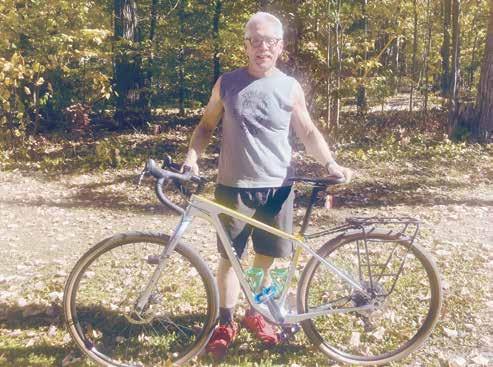
his 6-year total to 3,081 miles and $24,959. His personal Great Cycle Challenge page charts his rides, showing maps and routes, and he said, “This year, my shortest ride was 7 miles and my longest was 65.” His 53 sponsors — some individuals, some businesses — offered ongoing feedback on his rides over the course of the month, and
that encouragement helps Vallely to keep cranking.
Andrew Raffensperger wrote, “So proud and grateful! Marks battle and the hope, courage and determination he has shown, has encouraged me to persevere through

Until breast cancer can be prevented, we can empower women by promoting early detection and treatment.
What you can do:
• Learn and Educate: Understanding the signs, symptoms, and risk factors
• Get Screened: Women 40 and over should get a yearly mammogram
• Spread the Word: Share this life-saving information with others in your life
Join us this Breast Cancer Awareness Month as we encourage more women to get screened.
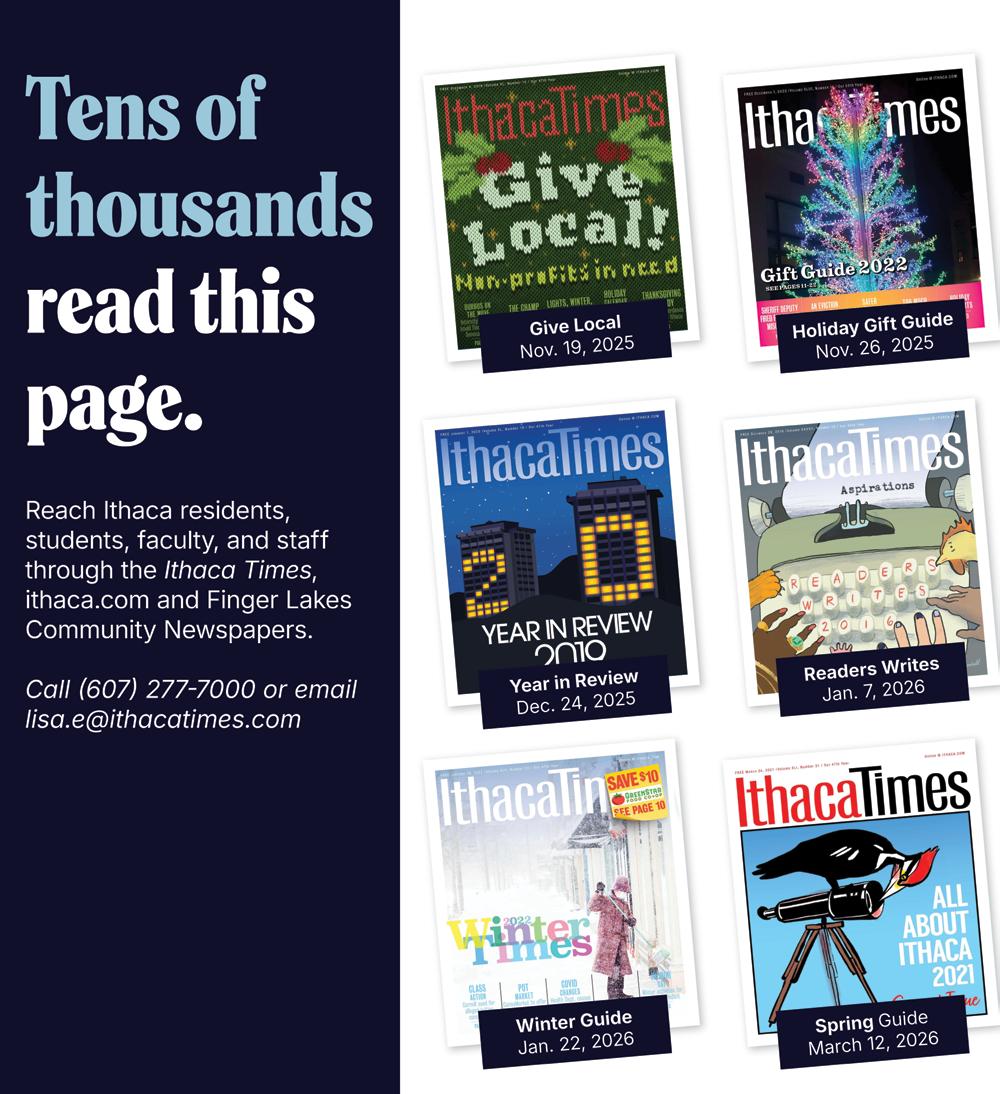
By Maddy Vogel
Rob Montana, current communications manager for Visit Ithaca, will bring over two decades of experience in communications and leadership to his new role as vice president of the Tompkins Chamber. The Chamber announced his appointment in a press release on Oct. 1.
Montana was chosen from a group of over 100 applicants, in part due to his ability to foster strong relationships with community and business leaders. The Cham-
ber said these skills, along with his skills in developing strategic initiatives, will play a key role in Chamber leadership as it supports Tompkins County’s economic and workforce development, and enhances the community’s quality of life.
Montana served as the Managing Editor of the Ithaca Times for several years before departing from the role in 2013. He has worked for several other publications like Tompkins Weekly and the Evening Tribune. This community journalism experience, paired with his nonprofit experience, will bring a community-focused

leader to the Chamber, CEO and President Peggy Coleman said.
“We were looking for the right person to elevate our work,” Coleman said. “Rob’s passion for community building for the greater success of the Tompkins County business community is inspiring. I look forward to working with him in this new capacity and celebrating the positive impacts he makes.”
In his role as vice president, Montana will collaborate with Coleman on long-term strategic planning to enhance the local business climate. He will also oversee the Tompkins County Employer Resource Network, manage the Live + Work in Ithaca initiative and administer the Tompkins Chamber Foundation fiscal sponsorships of Tompkins Connect and Ithaca Pride Alliance.
“I am grateful for the opportunity to serve as Tompkins Chamber’s vice president and continue working with my dedicated colleagues to build upon the organization’s work in Tompkins County,” Montana said. “Building relationships with others in a way that strengthens the community is work I am excited to continue doing to keep Tompkins County a great place to live, work and visit.”

Aly Evans, chairperson of the Tompkins Chamber Board of Directors, expressed excitement for the new leadership at the Chamber. Coleman was named as President and CEO in March.
“I could not be more excited for the future as Rob steps into the VP role, combining his skills with that of Peggy as President,” Evans said. “Both leaders have Tompkins County in their hearts and will do all they can to facilitate a healthy and connected community.”
For more information about the Tompkins Chamber and its initiatives, visit tompkinschamber.org.

By Jake Sexton
Tompkins County announced its new Amplify grant, which offers as much as $5,500 for “grassroots initiative[s], nonprofit[s], or small business[es],” that show positive impacts in the local community. The application process first opened on Sept. 16, with a deadline of Oct. 15.
The grant’s funding, allocated from the 2025 county budget, was unanimously approved by the county legislature with the hopes of financing a singular recipient, but the selection committee is willing to divide the grant among applicants whose proposals illustrate “significant potential for community impact.” Created in response to systemic inequalities in counties across America in the last five years, the grant is designed to be intentionally low-barrier, allowing flexibility for impactdriven initiatives seeking to improve the community.
The recipient(s) of the Tompkins County Amplify grant will be announced during the GARE Local Meeting, taking
place in Ithaca from Oct. 20 to 22 of this year. GARE, the Government Alliance on Race and Equity, is a network dedicated to educating communities and companies on the importance of connectivity, shared learning, and foundational leadership skills in vain of achieving racial equity.
The October event marks GARE’s first meeting in Tompkins County, serving as a significant opportunity for community and local government to begin collaborating on equity strategies.
“This is a moment to amplify the labor, leadership, and legacy of our most resilient community members,” said Charlene Holmes, Chief Equity and Diversity Officer for Tompkins County in the press release. “Amplify gives communities the mic; we’re just here to make sure the volume is turned all the way up.”
For those interested in applying to the Amplify grant, a Microsoft Forms application is available on the Tompkins County website. Additionally, those who apply are encouraged by the selection committee to submit any materials via email to Charlene Holmes, Chief Equity

& Diversity Officer for Tompkins County, at cholmes@tompkins-co.org with the subject line “Amplify Grant Submission.” However, supplementary content is not required as a part of the application
process. These materials may include presentations, proposals, personal videos, YouTube content, or any other supplemental resources applicants find appropriate.

Mukesh Sharma, MD
Guthrie is excited to introduce Mukesh Sharma, MD, our newest cardiologist now caring for patients in Cortland and the surrounding area.
Dr. Sharma is a fellowship-trained, board-certified cardiologist dedicated to providing high-quality, patient-centered care. His areas of expertise include:
• Nuclear cardiology
• Cardiovascular disease
• Echocardiography


Binghamton, NY, September 24, 2025—
Coughlin & Gerhart, LLP is pleased to announce Corinne K. Cavanaugh has joined the firm as an associate. Her practice focuses on public law, with an emphasis on representing municipalities in land use, zoning, and planning matters.
Prior to joining the firm, Cavanaugh practiced for several years at a firm in Secaucus, New Jersey, where she served as a
paralegal, law clerk, and later as an associate attorney in the firm’s land use and planning group. In that role, she regularly appeared before municipal boards, drafted redevelopment plan amendments, advised on environmental compliance issues, and handled matters ranging from real estate transactions to guardianship proceedings. She also gained public-sector experience with the City of Bayonne Law Department and Municipal Court, and earlier interned with the Connecticut General Assembly, where she was recognized with a General Assembly Citation for exemplary legislative service.
Cavanaugh earned her J.D. from Widener University Delaware Law School, where she was active in the Latin American Law Students Association. She received her B.A. in Political Science from Sacred Heart University and participated in the University’s Pre-Law Club.
She is admitted to practice law in New Jersey and Commonwealth of Pennsylvania. Her admission to the New York State bar is pending.
“Corinne brings a wealth of experience in land use and municipal matters,” said Rachel Abbott, Managing Partner of Coughlin & Gerhart. “We are delighted to welcome her to the firm and look forward

to the important work she will do for our municipal clients and communities.”
Coughlin & Gerhart is proud to welcome Cavanaugh to the firm’s team of professionals.
Excellus BCBS names seasoned
upstate
NY hospital leader Martin Stallone, MD, as executive vice president, chief healthcare services officer

NY — Martin Stallone, MD, has been named executive vice president, chief healthcare services officer of Excellus BlueCross BlueShield and its parent com-
pany, The Lifetime Healthcare Companies. Stallone is currently CEO of Centralus Health. He will start his new role on Dec. 1, 2025.
“As a local, nonprofit health plan, we increasingly partner with hospital systems and provider practices to help improve community health while tackling the growing challenge of rising healthcare costs,” said Jim Reed, CEO and president of The Lifetime Healthcare Companies.
“We’re thrilled to welcome Dr. Stallone to our team,” he added. “His clinical leadership in health care delivery, combined with his understanding of our regional health systems, will help us drive innovation and deepen our provider partnerships to better serve our communities in Central New York and throughout upstate New York.”
Centralus Health is a health care system formed through the affiliation of Cayuga Health and Arnot Health. It encompasses five hospitals serving communities across New York’s Southern Tier, Finger Lakes and Central New York regions.
In addition to his role as CEO of Centralus Health, Stallone served in a variety of leadership positions during his 17 years at Cayuga Health.
Continued on Page 27

By Maddy Vogel, Managing Editor
This week marks National Newspaper Week, and what better way to celebrate than by reading your local paper. In today’s world, where local news is increasingly scarce and trust in the media is rapidly diminishing, the Ithaca Times serves as a crucial source of local information. But what makes the Times different from other local papers?
We aren’t fueled by a wire service, which means we don’t pull content from other outlets like the Associated Press or USA Today. Nearly every word you read in this paper is crafted by a member of our team, whether they are just starting out or have been contributing to the paper for more than 50 years.
We’re a free weekly paper. As local news struggles to survive off advertising models, most outlets have implemented paywalls and shifted to subscriptionbased models, but the Ithaca Times has remained free and accessible. People who aren’t familiar with the paper are often shocked to hear it’s free, a scarce but valuable resource to many. But writers and editors don’t work for free, and our degrees certainly weren’t cheap. Printing a paper is far from affordable, but we still do it because we know many readers depend on it. Plus, there’s something so special about holding a physical paper.
We aren’t owned by a national corporation. Earlier this year, the Ithaca Times and Finger Lakes Community Newspapers were acquired by Pathways to Equity, Inc. a newly-formed nonprofit organization dedicated to enhancing local news. After decades of leadership from Publisher Emeritus Jim Bilinski, the Times entered a new chapter. Under Pathways to Equity, we’re actively exploring new ways to expand coverage in our region and build critical, foundational relationships with local organizations.
But we offer more than just news. When the Ithaca New Times and the Good

Times Gazette combined in 1978 to form the Ithaca Times, we promised to keep to the newsy roots of the Ithaca New Times while offering the Arts and Entertainment coverage readers enjoyed in the Good Times Gazette. We have kept this promise after nearly half a century in circulation.
This paper, historically, has served as a starting point for many early career journalists, mentoring an aspiring journalist into a solid reporter or editor for just a few years before they jump to a bigger outlet. It may still serve as such, but this doesn’t mean that these reporters don’t care about the communities they report on. Many of our writers are locals, native Ithacans. Others came here for school or were brought here by other life circumstances and are still planting their roots. But I know one thing, our team cares deeply about the communities it serves.
Most know journalism isn’t an easy industry. There’s long nights of reporting on endless city hall, school board, county legislature and town board meetings — virtually every taxing entity in Tompkins County is reported on by our team. There are corrections when we get it wrong, and emotional weight when covering stories that hit close to home. While we would love to cover every story in the community, our team is small, and sometimes stories slip through the cracks. However, we always welcome feedback which helps us grow.
I have stayed up all night with my reporters working on stories in an effort to get our readers the most accurate news quickly. Before becoming editor, I spent (and
Continued on Page 23
Strong communities don’t just happen. They rely on connection—residents knowing what’s going on, businesses reaching the customers who keep them open, and citizens having the facts to make good decisions. Local newspapers provide that connection in ways no other source can.
In today’s fractured media environment, trust is the rarest commodity. Confidence in “the media” is low. Only 18% of Americans say they trust news on social platforms, and fewer than one in four trust cable networks. But nearly two-thirds say they trust their local newspaper—more than double the confidence placed in most other outlets.
In an era when anyone can post anything online, that clarity makes newspapers stand apart.
Newspapers provide the facts that keep civic life running: city budgets, school board debates, and local elections that rarely make national headlines but matter most to daily life. They also highlight the stories that make a community feel connected: high school sports, neighborhood events, new restaurants, and profiles of
people who make a difference.
Your local newspapers have evolved to meet readers where they are—on websites, mobile apps, and email newsletters. What hasn’t changed are the standards. Accuracy, ethics, and accountability still guide the work. That combination of modern delivery and traditional integrity is why people continue to turn to their local paper.
The same trust strengthens the local economy. Research shows consumers act on newspaper ads more than on ads delivered by TV, radio, or digital platforms. People see local business advertising as part of the same reliable package as the news. For a small business competing with national chains and online platforms, no other channel delivers the same impact. When residents trust the paper, they trust the businesses that support it.
The absence of a local paper leaves a mark. Voter turnout declines. Fewer residents attend public meetings. Government oversight weakens and borrowing costs rise. Small businesses lose their most effective way to reach local customers. And without a trusted source tying things
Continued on Page 23

By Jake Sexton
Did you know that the New York State Assembly’s 2019 bill, the Farm Laborers Fair Labor Practices Act (FLFLPA), wouldn’t have been possible without the foundational precedents set by a decades-long effort waged by California farm workers?
Ithaca Times contributor Jake Sexton uncovered this in the Oct. 5, 1975, issue of The Ithaca Times. In the article “UFW Battles Teamsters Union at Polls,” reporter Cathy Wedge interviewed Cletus E. Daniel, a labor historian and professor at the New York State School of Industrial and Labor Relations (ILR). Wedge and Daniel discussed violent turf wars and intimidatory tactics brewing at polling offices — primarily a Sept. 10 incident at the Gallo elections in California — between the United Farm Workers (UFW) and teamsters union. The article covers events leading up to the riots as well as the impact of the California Agricultural Labor Relations Act on farmworkers and unions.
To understand how a state law passed half a century ago, 2,700 miles away, impacts Ithaca today, one must understand the relationship between unions and agricultural labor, especially in regarding migrant and seasonal workers. In the article, Wedge and Daniel discuss how Cesar Chávez’s formation of the UFW in California as an opposition to the nationally backed, nonrepresentative Teamsters Union led to a decade-long clash and groundbreaking legislation.
Daniel attributes the historical exclusion of manual farm laborers from unions to agricultural interest lobbyists during the New Deal, arguing that their employees were “personalized,” with “no interest in unionization.”
Daniel says California’s quarter-million farm workers historically received negligible pay and housing considering the impact of the work on their health and their lack of political power. A lack of U.S. citizenship and a general miseducation of their rights meant they lacked control over decisions that impacting their lives.
This would change as California’s Chicano movement and a growing sentiment of la raza, or the feeling of heritage among Spanish-Americans in pursuit of fair treatment and self-determination, began gaining traction in the 1960s. Revered social
activist and leader, Cesar Chávez, began the UFW, organizing numerous strikes including the five-year Delano Grape Strike and was committed to nonviolent approaches to protesting. By the time the grape strikes came to a close, a majority of California table grape growers signed UFW contracts.
After the Delano Grape Strike, many lettuce growers in the Salinas Valley signed “sweetheart contracts” with teamsters after seeing the impacts of the strikes. These agreements were between employers and labor union executives, were favorable to employers, and were typically conducted behind closed doors without union approval. As a result, approximately 10,000 farm workers on California’s Central Coast went on strike starting August 1970. One such instance is the strike at the Antle Lettuce Farm, where Daniel said inklings of credible allegations of teamsters intimidation began.
A court order was issued against Chávez in response, demanding he disassemble the strike — an injunction Chávez would ultimately ignore, landing him in jail for around two weeks. The detention of Chávez immediately drew national attention to the UFW and their mission.
While in prison, Chávez was visited by a number of notable political and civil rights activists or their families, such as Coretta Scott King and Ethel Kennedy, further highlighting the efforts of Chávez and the UFW as underdogs fighting for their civil liberties. A nationwide 1975 Louis Harris poll cited by the UFW, around 17 million Americans were boycotting California growers grapes from 1973 through 1975, with a large percentage also boycotting lettuce and Gallo wine in solidarity.
With the cultural zeitgeist of America collectively becoming increasingly aware of the drama building in California, pressure began mounting on the state legislature to act before total pandemonium erupted. By spring of that year, the state senate began moving the necessary pieces to get involved, and following the inauguration of Jerry Brown as California governor in 1974, Sacramento worked tirelessly to draft and pass the ALRA into state law, becoming the first piece of legislation to normalize collective-bargaining rights for farm laborers.
The law established state-backed election systems through the Agricul-
tural Labor Relations Board (ALRB) and investigated reports of violence and voter intimidation. These reports include the allegations at the Antle lettuce farm and Gallo polls, alongside allegations of armed men waiting in fields, “non-agricultural” security guards who were allowed to vote and blatant coercion through open-ended threats, as outlined by Daniel. Additionally, these allegations are corroborated in the ALRB's first annual report from 1975-1977, as well as historical legal motions from ALRB.ca.gov, such as Case No. 75-CL-109-M, detailing assault and battery charges brought against Teamsters Union Local 875 on Sept. 4, 1975 by the UFW, eventually finding the accused Teamsters agents guilty on Feb. 9, 1977.
David concludes the interview with his contention that the sheer importance of this piece of legislation for the future, stating “farm laborers want unionization, and will continue their struggles until a proper atmosphere has been established […] Migrant farmworkers will gain their rights as part of the American workforce.”
The ALRA, the UFW’s struggle against the Teamsters, and the expansion of farmworkers’ labor unions had lasting impacts not only in California, but across the entire country.
From September 1975 through the beginning of the following year, hundreds of elections were held with a majority being won by UFW voters; growers, however, disregarded election results and illegally supported the teamsters. With the sheer volume of elections not only being held, but being illegally contested, the ALRB temporarily shut down in January 1976 due to a lack of funding, as reported in a comprehensive historiography by David Willhoite published in 2012. It was only through the efforts of Chávez and the UFW that Proposition 14, a bill which would restore funding to the ALRB, found itself on the November ballot of that year, passing and reopening the board.
Years later, the UFW and Teamsters unions found peace in March, 1977, when the president of the Teamsters met personally with Chávez and officially ended their meddling and contesting of union elections in California, as reported by the the New York Times. Following this point, UFW strikes had finally begun slowing down with the ALRB diligently ensuring that growers contracting union
farmworkers adhere to the policies of the ALRA, which has seen additional expansions to laborers’ rights as recently as September 2022.
This story does not end on the 1970’s California Pacific Coastline. Rather, the impacts of the ALRA laid the foundation for agricultural laborer laws and protections throughout the country, inspiring new legislation across the country. The same debates from 1975 surrounding access, intimidation, learning how or why you should learn your rights and vote, still linger half a century later on a national scale. Instead of occurring merely at the state or community level, similar allegations and debates surrounding voting restrictions now play out nationally. From disputes over voter ID laws, growing concerns regarding access and validity of mail-in ballots, and the time restraints that make voting difficult for many in this country. California’s 1975 law gave farmworkers a vote and amplified their voices.
The ALRA’s legacy isn’t a broad, generalizing scope of deeper issues surrounding migrant farmworkers and voter interference. Instead, the expansion of workers rights and self-determination has come to affect Ithacans. In 2019, the state assembly passed the Farm Laborers Fair Labor Practices Act (FLFLPA) providing expansions to collective-bargaining abilities for workers. From its initial activation on Jan. 1, 2020, through its finalization on Feb. 22, 2023, our lawmakers recognized the voices and outcries of our farmworkers, with Albany working hard to accommodate their needs the same as Sacramento did in 1975.
For Ithacans, the legacy of the UFW grape and lettuce strikes is seen today in our tables and grocery stores: the fairer hours and collective-bargaining abilities for our farmworkers by the 2019 FLFLPA have supported the farms that feed our community today. Through the FLFLPA, local community-member support and investment, as well as institutions like Cornell University's commitment to outlining and reporting on the 2019 legislation to inform those impacted of their rights, these liberties would not have been possible without the leadership and organization of Cesar Chávez or
By Kira Walter
Friends Of The Tompkins County Public Library works tirelessly to coordinate its renowned twiceyearly book sales, and this weekend, the fall 2025 shopping season begins. From Oct. 11-13, 18-20, and 25-28, all are welcomed to peruse a collection of up to 250,000 books, dvd’s, cd’s, games and puzzles.
With an early 8 a.m. kick off for the first Saturday, open hours run from 10 a.m. to 8 p.m. at 509 Esty St. The sale also features special shopping windows, accommodating seniors and those with disabilities from 10 a.m. to 4 p.m. on Wednesday, Oct. 22. From 4 p.m. to 8 p.m. later that day, the location is open specifically to students.
While generating revenue for the library, Friends Of The TCPL focus on affordability: no prices exceed $4.50 and items get cheaper throughout the season. Monday the 27th is “Dime Day” — items on the main floor are available at 10 cents only, while Tuesday the 28th is “Bag Day”: anyone is able to bring their own bag and fill it for a dollar.
When asked about preparation for this Fall, coordinator Chris Hallam gave some insight into the sheer amount of effort involved in handling this many donations.
“We spend about 14,000 hours for each sale, getting books ready,” she explained. “That’s about 200 volunteers, spending that much time.”
Products are sorted into over 75 categories, with 30,000 children’s section items this season, and an extensive Collector’s Corner with rare finds.
“We are in the top 10 both for the amount that we sell and the money that we make,” she said.
Since its founding in 1946, this sale has generated over 8 million dollars for TCPL and other local libraries. The astounding scale of impact this project has is unique to Ithaca’s location and the academic emphasis here.
“We have a lot of people here that are retired from Cornell [and] Ithaca College,” Hallam said. “This is where all of those books go when those people retire, the school teachers all bring us their books.”
Retired volunteers are also assisted by local friends of the library in Trumansburg,

Friends of the Tompkins County Public Library will host its bi-annual book sale this month, with opening weekend taking place Oct. 11-13.
(Photo: Provided/Friends of the Tompkins County Public Library)
Interlaken and Cayuga County: they bring unpurchased items from their sales elsewhere. Before the seasonal store commences, school libraries are able to take up to 50 books from the selection.
Following the shopping period, non-profit organizations comb through the remainder of items, and the rest are shipped to Zoom Books in Canada. Zoom Books donates some books overseas to charities fighting illiteracy, and some are sold online. Proceeds from online sales come back to Friends Of The Library, then the final items are taken to a paper pulp factory.
“The building is emptied out between each sale. Everything on the shelf is fresh, nothing is leftover,” said Hallam.
While managing the distribution of all books, coordinators also award grants to nonprofits in Tompkins County for reading materials. Residents can receive educational grants if pursuing a degree in library sciences.
Hospicare, Rural Youth Services, Southworth Library, The Red Bookshelf, and countless other nearby nonprofits have implemented grants from the initiative.
When asked to speak about the sale’s reputation in Ithaca, Hallam spoke to popular thought.
“The sale has become iconic,” she said. “They don’t even call it the friends of the library sale anymore, they call it spring book sale and fall book sale.”
So many purchases are generally made in the first few days that shoppers are limited to a maximum of 50 items.
In words to newcomers, Hallam’s advice is simple. “Just come in and just browse. Don’t be afraid to ask questions.”
Volunteers can’t guarantee a book is present, but they can point you in the right direction. And with an impossible 2 miles worth of material up for sale, it’s hard not to find something once on the reading list.
By Peter Rothbart
Blues Traveler, a well-respected, blues-based jam band, makes a quick stop at the State Theatre on Friday, Oct. 10. Formed in 1986, they developed a reputation for good music and bad behavior, not unlike other club bands in New York City in the early 1990s.
Blues Traveler has always been a hard driving blues and rock group. Fortunately, they’ve toned down their partying lifestyle as the band has grown musically. They’ve moved beyond the basic blues beat and harmonies. Their chords have become a bit more complicated, especially as they developed into a jam band, known for
Friday, Oct. 10 at 8 p.m. State Theatre Ithaca, NY Tickets at stateofithaca.org
their clever and expansive improvisations tagging one song onto another, like the Grateful Dead or Phish.
After having established themselves as a band that opened for the likes of the Jerry Garcia Band, Santana, and the Allman Brothers, the band’s Grammy winning song, “Run-Around” enabled them to move to the top of the marquee. They began experimenting with adding strings to their arrangements. This softened sound pulled them in a different direction as they tried to accommodate a changing listener audience.
Lead singer, songwriter, and harmonica-player John Popper still fronts the band, albeit with a very welcomed slimmer physical profile. Original bandmember Bobby Sheehan has left this world, no doubt for a party elsewhere, but other original members, Chan Kinchla and Brendan Hill are still performing. They are joined by Tad Kinchla and Ben Wilson.



Blues Traveler will perform at the State Theatre in Ithaca on Friday, Oct. 10. (Photo: Provided/Colorado Music Experience)
Recent shows indicate that they are returning to familiar electric blues territory, guided by Popper’s original and convincing harmonic playing. Popper cites Elmore James’ and Paul Butterfield’s harmonic playing as a founding inspiration for the band’s signature sound. Although Popper can blow a melody with as much lyricism and finesse as his idols, it is his rhythmically sophisticated harmonica work that defines the band.
Over the years, the band has absorbed many of the rock and blues influences around them. Hints of Southern rock underlie some of their songs. They are not above the occasional pyrotechnic slash of a power chord. And their vocal
harmonies are more organically blended and are occasionally unexpectedly sophisticated.
Despite their earlier reputation for hard partying, the band has settled comfortably into their own niche within the blues genre. Tightly rehearsed vocals espouse tongue-in-cheek lyrics that should not be taken too seriously. After all, the blues ain’t all bad or all sad.
Peter Rothbart is a Professor Emeritus of Music at the Ithaca College School of Music, Theatre and Dance where he taught electroacoustic and media music for 40 years. He remains active as a classical, jazz, and pop musician.





























By Peter Rothbart
The Cayuga Chamber Orchestra opens its theme-based 2025-2026 orchestral series on Saturday, Oct. 9 with Northern Lights, a program that reflects on four Northern European composers: Estonians Arvo Pärt and Lembert Beecher, Norwegian Edvard Grieg, and Finland’s Jean Sibelius. Music Director Guillaume Pirard’s bold programming reinforces his continuing commitment to performing adventurous and challenging music outside of the mainstream classical canon.
“Tell Me Again” by contemporary Estonian-American composer Lembert Beecher features cellist Karen Ouzounian, for whom the work was written. The three movement work reflects both the composer’s and soloist’s contemplations on their families’ stories of escape from wars, the ensuing trauma of relocation, and the reinvention of their lives.
For Beecher, it was a story of his grandmother and mother fleeing Estonia during World War II and spending 5 years in a relocation camp. For Ouzounian, who grew up in Beirut after her Armenian parents fled Turkey and then the Lebanese Civil War, stories are a way of processing life experiences and passing that history to the other family members.
Saturday, Oct. 11 at 7:30 p.m.
Ford Hall, Ithaca College
Tickets at https://www.ccoithaca.org/ and at the door
The score is filled with a myriad of tempo changes and extended instrumental techniques that challenge musicians to play their instruments in unusual and unconventional ways. The orchestra’s handling of these techniques makes them sound effortless–they are anything but–even at breakneck tempos. Cellist Ouzounian calls upon her pristine and commanding technique to challenge the orchestra’s overwhelming whirlpools of sound.
The opening movement to “Tell Me Again” is fiendishly fast and pointillistically dense. Gestures and motives ricochet back and forth, intentionally burying the solo cello which struggles to be heard. The cello resorts to echo-like gestures (the story repeatedly being retold) before breaking free from the orchestral carnage.
In the second movement, the cello quotes an Estonian folksong and cajoles the orchestra into a call and response; a story taught and learned. The dynamic third movement is filled with a motor-like continuous energy, incorporating figurative elements of the previous two movements into a new narrative, reinvigorating the family history for those who listen.
Arvo Pärt’s Symphony No. 1 is titled, “Polyphonic” and was written before he took a hiatus from music and developed his own compositional technique called “tintinnabuli.” He is perhaps the most performed contemporary living European composer.
Written in 1963 while Estonia was still part of the Soviet Union, Pärt used a politically risky twelve-tone technique, avoiding traditional tonality which might have been more acceptable to the Politburo.
The work leaves no good motive undeveloped. It seethes with aggressive and repeating


rhythmic figures that relentlessly propel the thickly packed orchestration forward; like an atonal Ravel’s Bolero gone wild.
Whether the laconic undertones of Norwegian composer Edvard Grieg’s music can be attributed to his lifelong poor health or to the nature of the Nordic life is a matter of conjecture but his Two Elegiac Melodies, Op. 34, carry a distinctive flavor of loneliness and quietude. The two-movement melancholic work takes inspiration from poems by Norwegian poet Aasmund Olavsson Vinje.
The first movement, “Wounds of the Heart,” questions how to live a life while suffering the pains that are a part of it. Musically, it’s a forlorn lament that reflects a restless mind wrestling with existential questions. It begins in a minor key and quickly wanders through a series of modulations. A more forceful second theme reflects the poem’s epiphany that faith,
inner strength, and resolve are the keys to enduring life’s onslaught. The movement triumphantly resolves into G major. The second movement, “The Last Spring,” is the poet’s and composer’s vision of the beauty of the country in spring as they realize they might be seeing it for the last time.
Jean Sibelius’s Kuolema (Death) Valse triste, Op.44, No. 1, is a short but haunting work originally written for a play by the same name. It wreaks of internal churning, hinting at emotional upheaval and probably reflects Sibelius’s ongoing depression. Still, the minor key waltz is a powerful and danceable reflection of inner turbidity.
Peter Rothbart is a Professor Emeritus of Music at the Ithaca College School of Music, Theatre and Dance where he taught electroacoustic and media music for 40 years. He remains active as a classical, jazz, and pop musician.

Bars/Bands/Clubs
10/8 Wednesday
Redd & The Paper Flowers | 6 p.m. | Ithaca Beer Taproom, 122 Ithaca Beer Drive | Free Jazz Jam Session with the Marc Devo Quartet | 6 p.m. | Garrett’s Brewing Company, 1 West Main Street | Free
10/9 Thursday
Notorious Stringbusters | 5:30 p.m.
| South Hill Cider, 550 Sandbank Road
Brewhouse Blues Jam | 6 p.m. | Hopshire Farm & Brewery, 1771 Dryden Rd. | Free
10/10 Friday
Oktoberfest Blues & Brews
Featuring Erin & The Backwoods Blues Project | 5 p.m. | Library Place, 105 W Court Street | $12.00 Temple Cabin Band | 5:30 p.m. | South Hill Cider, 550 Sandbank Road
The Ministry of Culture: Songs to fan the flames of discontent | 8 p.m. | The Downstairs, 121 W M.L.K. Jr. St. THE KENNEDYS | 8 p.m. | Lansing Performing Arts Center- 1004 Auburn Rd., North Lansing NY 13073, 1004 Auburn Road
10/11 Saturday
The Ambre Lynae Project | 5:30 p.m. | Aurora Brewing Company, 1897 State Route 90 North | Free
10/12 Sunday
Calea Lea | 7 p.m. | The Downstairs, 121 W M.L.K. Jr. St.
10/13 Monday
Indigenous People’s Day Celebration with Arvel Bird | 2 p.m. | South Hill Cider, 550 Sandbank Road | Free
Jazz Mondays with Dave Davies RhythmMakers | 5:30 p.m. | South Hill Cider, 550 Sandbank Rd.
10/14 Tuesday
Dead Dive Happy Hour w/ Dead and Friends | 5 p.m. | Deep Dive Ithaca, 415 Old Taughannock Blvd. | $8.00 - $15.00
Taughannock Live Music
Series:Rob Ervin | 5 p.m. | Inn at Taughannock Falls, 2030 Gorge Rd.
10/15 Wednesday
Jon Dember & Friends | 4 p.m. | Trumansburg Farmers Market, Trumansburg | Free
Concerts/Recitals
10/8 Wednesday
Trumpet Ensemble and Trombone Troupe Concert | 7 p.m. | Ford Hall, Ithaca College | Free
Ensemble Dal Niente | 8:15 p.m. | Ford Hall, Ithaca College School of Music, Theatre, and Dance
10/9 Thursday
Keyboard Energies II: The Keyboards Strike Back (CU Music) | 7:30 p.m. | Barnes Hall, 129 Ho Plaza | Free

10/10 Friday
Junior Recital: Jayna Simeon, mezzo soprano | 7 p.m. | Hockett Family Recital Hall, Ithaca College
Blues Traveler | 8 p.m. | State Theatre of Ithaca, 107 West State St. | $48.00
10/11 Saturday
Senior Recital: Faith Tomasula, soprano | 3 p.m. | Hockett Family Recital Hall, Ithaca College | Free Cayuga Chamber Orchestra: Northern Lights | 7:30 p.m. | Ford Hall, Ithaca College, 953 Danby Rd. | $15.00 - $45.00
Maddy Walsh & The Blindspots AND Sophistafunk | 8 p.m. | Center for the Arts of Homer, 72 S Main St.
10/12 Sunday
Coletti Trumpet Studio Recital | 1 p.m. | Hockett Family Recital Hall, Ithaca College.
10/13 Monday
Junior Recital: Aidan Zajkowski, bass-baritone | 7 p.m. | Hockett Family Recital Hall, Ithaca College. | Free
Arvel Bird — Celtic Indian Concert | 7 p.m. | First Presbyterian Church of Ulysses, 69 E Main St. | $20.00 - $40.00
10/14 Tuesday
Student Ensemble: Jazz Ensemble | 7 p.m. | Ford Hall, Ithaca College
10/15 Wednesday
Guest Recital: Zachary Costello, saxophone | 7 p.m. | Hockett Family Recital Hall, Ithaca College
Kathleen Edwards | 8 p.m. | Hangar Theatre, 801 Taughannock Blvd.
Bonnie and Clyde | 2 p.m., 10/8 Wednesday | Merry-Go-Round Playhouse, 6877 E. Lake Road | Set to a riveting score combining rockabilly, blues, and gospel music, BONNIE & CLYDE is an unmissable, action-packed musical about grabbing the spotlight any way you can. Check website for additions dates and times. |
ELT Presents Kimberly Akimbo | 7:30 p.m., 10/9 Thursday | Clemens Center, 207 Clemens Center Parkway | Kimberly is a smart, funny New Jersey teenager—who just happens to look like a woman in her 60s. She has a rare genetic condition that makes her age four times faster than normal.
Pedro and the Odyssey of the Parana | 10:30 a.m., 10/11 Saturday | The Cherry, 102 Cherry St. | All the way from ARGENTINA — Leonor brings the story of Pedro, a character that comes to life out of her giant book. | $1.00 - $12.00
Running to Places presents: ANNIE jr | 12 p.m., 10/11 Saturday | Hangar Theatre, 801 Taughnock Blvd. | Running to Places is excited to present: ANNIE jr (FREE Event!) | Free Playwrights Jam | 5 p.m., 10/12 Sunday | Kitchen Theatre Company, 417 W. State / W. MLK, Jr. Street | Lively readings of theatrical works in progress. Join as a playwright, actor, audience member, or all three! | $0.00 - $10.00
Is a Hum a Warning? | 5:30 p.m., 10/15 Wednesday | Class of ‘56 Dance Studio Theatre, Schwartz Center for the Performing Arts, 430 College Ave. | A performance lecture by Choreographer Roya Carreras Fereshtehnejad that explores how rupture becomes reclamation and how sound and gesture can hold protest, pleasure, and futurity as part of her ongoing work as a Persian movement researcher. | Free
Beloved Artistic Community Meet Up | 6:45 p.m., 10/15 Wednesday | Ithaca Community School of Music and Arts, 330 East State Street | Join us for a theatre workshop — intro to Rasaboxes: a playful approach to embodying emotions through the use of breath, body, voice, and sensation. | Free King James | 7 p.m., 10/15 Wednesday | Kitchen Theatre Company, 417 W. State / W. MLK, Jr. Street | This fresh, thoughtful comedy asks what it means to be a friend, to be a fan, and whether any relationship can survive the ultimate betrayal: LeBron leaving Cleveland. | $10.00 - $55.00
Opening Reception: Passages — artwork by Joanne Thorne Arnold | 4 p.m., 10/9 Thursday | Center for the Arts of Homer, 72 S Main St | The Road Home : roadside photographs by Ariel Bullion Ecklund | 5 p.m., 10/9 Thursday | Studio 203, 201 Dey Street, Suite 203 | The Road Home is a small collection of limited edition photographs taken from the roadside. Community Arts Partnership Networking Night | 5:30 p.m., 10/9
Thursday | Community Arts Partnership of Tompkins County, 110 N. Tioga Street, Tompkins Center for History and Culture, on the Ithaca Commons. | Come and hang out with fellow artists and creatives. | Free 27th Annual Greater Ithaca Art Trail Open Studio Weekends! ! | 11 a.m., 10/11 Saturday | Tompkins County, 320 W State St. | EVENT WEBSITE: ArtTrail.com Go on an adventure through gorgeous fall foliage with multiple artist studios as your destination!
Assemblage and Collage exhibit | 12 p.m., 10/11 Saturday | The Gallery at South Hill, 950 Danby Rd. South Hill Business Campus South Hill Business Campus | Assemblage and Collage features the works of Jackie Dickinson, Chris Knickerbocker, Carol LaBorie, Rachel Philipson, Mary Reynolds, Michael Sampson, Dee L. Sprague, and Mia Zufall. All using different forms of Assemblage and Collage. | Free Open Season 9 | 1 p.m., 10/11
Saturday | The Cherry Gallery, 130 Cherry St | The Ithaca Print Commons’ iconic annual exhibition, at the Cherry Gallery for the first time | Free
Saltonstall Open House: Readings + Art | 4 p.m., 10/12 Sunday | Saltonstall Foundation for the Arts, 435 Ellis Hollow Creek Road | Save the date and join us for Saltonstall Foundation’s final Open House of the 2025 season! | Free
Senator Webb’s Screening of “Murder Has Two Faces” | 5 p.m., 10/10 Friday | Cinemapolis, 120 E. Green Street. | Join me for a powerful screening of “Murder Has Two Faces,” a compelling docuseries created by the brilliant Lisa Cortes, with journalism legend Robin Roberts. | Free
5th Annual FLX Cider Fest & Market hosted by South Hill Cider | 4:30 p.m., 10/9 Thursday | South Hill Cider, 550 Sandbank Road | Join us for the Fifth Annual FLX Cider Fest & Market during NY Cider Week at South Hill Cider! Thursday, October 9, 2025, starting at 4:30 PM. 550 Sandbank Road, Ithaca, NY 14850. Groundswell Farm Fest | 6 p.m., 10/9 Thursday | Stone Bend Farm in Newfield, NY, 196 Porter Hill Rd. | Candor Fall Festival | 10/10 Friday | Candor Town Hall Pavilion, 101 Owego Road | From October 10th to October 12th, Candor will celebrate its 27th Annual Fall Festival!
13th Annual Little York Fall Fiber Arts Festival | 9 a.m., 10/11 Saturday | Little York Lake Pavilion, 6799 Little York Lake Road | Attention all knitters, spinners, felters, & craft enthusiasts of all kinds! Held at the Little York Pavilion, over 30 vendors will be on hand with yarn, roving, fleeces, felted products, clothing, unique holiday gifts, and decorations, along with pottery, maple products, soaps, and more! | $5.00
Contra Dance with George Marshall and Nobody’s Business| 10/11, Saturday,CSMA (330 E State St/ MLK Blvd) | 3-5 p.m. challenging dances; 5-6:30 p.m. potluck supper; 6:30 p.m. beginner’s workshop; 7-10 p.m. dance for all. Clean,soft-soled shoes. Admission for one session (afternoon or evening): $17 members/$20 nonmembers/$10 students. For both
SENATOR WEBB ’ S SCREENING OF “ MURDER HAS TWO FACES ”
FRIDAY, OCTOBER 10TH AT 6:00 PM
Cinemapolis, 120 E. Green St., Ithaca | Join Senator Lea Webb for a screening of the docuseries created by Lisa Cortes, with Robin Roberts. The 3-part series sheds light on the crisis of missing and murdered BIPOC women and girls. There will be a meet and greet with Cortes at 5:00 PM. The screening starts at 6:00 PM and will be followed by a Q&A. (Photo: Provided)

PEDRO AND THE ODYSSEY OF THE PARANA
SATURDAY, OCTOBER 11TH AT 10:30 AM
Cherry Artspace, 102 Cherry St., Ithaca | Leonor is a professional Argentinian
and actress. She brings the story of Pedro, a character who comes to life out of her giant book. (Photo: Facebook)
sessions: $32/$38/$19. Children 12 and under free. Cash, check, Venmo; no credit cards. hands4dancers.org
Greek Peak Fall Fest | 9:30 a.m., 10/11 Saturday | Greek Peak Mountain Resort, 2000 Rt. 392 | Description Fall Fest is back at Greek Peak. Make it an easy autumn Saturday close to home: gates at 10 AM, music at 12 PM, and lunch is included with your ticket. | $29.00 - $39.00
Newfield Covered Bridge Fall Festival | 11 a.m., 10/11 Saturday | Newfield Covered Bridge, Main Street | The Newfield Covered Bridge Fall Festival is fun for the whole family! Vendors, food, and music by “Sleeping Dogs” AND “90 Proof”. | Free Harvest Festival featuring The Petty Thieves | 12 p.m., 10/11 Saturday | Treleaven Wines, 658 Lake Road | 658 Lake Road | King Ferry, NY 13081 T: 315-364-5100 E: tastings@ treleavenwines.com | $5.00
Ithaca Men’s Soccer vs No. 25 Hobart College | 4 p.m., 10/8 Wednesday | Carp Wood Field | Cornell Volleyball vs Brown University | 7 p.m., 10/10 Friday | Newman Arena at Bartels Hall | Roller Derby Watch Party- World Championships | 12 p.m., 10/11 Saturday | Personal Best Brewing, 402 W Green Street | Come hang out, watch some derby, and make new friends on Saturday, October 11th, 12-4 p.m. at Personal Best Brewing. | Free
Ithaca Field Hockey vs No. 25
University of Rochester — In Memory of Kyra Feick | 1 p.m., 10/11 Saturday | Higgins Stadium
Ithaca Women’s Soccer vs Rensselaer Polytechnic Institute | 2 p.m., 10/11 Saturday | Carp Wood Field |
Cornell Men’s Soccer vs Princeton University | 4 p.m., 10/11 Saturday | Berman Field |
Cornell Volleyball vs Yale University | 6 p.m., 10/11 Saturday | Newman Arena at Bartels Hall |
Ithaca Men’s Rowing vs Freeman Cup | 4 p.m., 10/13 Monday | Cayuga Inlet
Cornell Men’s Soccer vs Colgate University | 7 p.m., 10/14 Tuesday | Berman Field |
Make Me a Monster — Kalynn Bayron | 5 p.m., 10/10 Friday | Buffalo Street Books, 215 North Cayuga Street | Join us at Buffalo Street Books with author Kalynn Bayron for a reading from her newest novel, Make Me a Mo nster
Friends of the Library BOOK SALE | 8 a.m., 10/11 Saturday | Regina Lennox Book Sale Bldg, 509 Esty St. | Friends of the Library Book Sale at 509 Esty St., Ithaca. Opens Saturday, Oct 11: 8 a.m. - 8 p.m. Continues Sunday-Monday, Oct 12-13: 10 a.m. - 8 p.m. | Free Come On Out! An LGBTQ+ Fiction Writing Workshop | 2 p.m., 10/11
continued from page 17
sometimes still spend) countless nights in the same meetings that they now report on. We're constantly balancing the demands of a weekly print edition with the daily demands of offering digital news on ithaca.com.
We’re a small but steadily growing team, many of us early in our careers. We might not always be perfect, but our team is devoted to reporting on this community with fairness and accuracy. We

Saturday | Tompkins County Public Library, 101 East Green Street | Join screenwriter/novelist Elisabeth Nonas for a 3-part workshop at the Library this Fall on Saturday afternoons. LET’S READ + TALK ABOUT CLIMATE — CLIMATE LITERATURE DISCUSSION | 4:30 p.m., 10/15
Wednesday | Buffalo Street Books, 215 North Cayuga Street | Join us at Buffalo Street Books for community-led conversations about climate change, seen through fiction and non-fiction books.
The Writers’ Room | 6 p.m., 10/15
Wednesday | Tompkins County Public Library, 101 East Green Street | Work on your writing project in the company of other writers. | Free
C ayuga Chamber Orchestra Family Concert Series | 4 p.m., 10/9 Thursday | Tompkins County Public Library, 101 East Green Street | Get swept up in the magic created by great stories and live music as the CCO and Tompkins County Public Library (TCPL) join forces for our annual Family Concert & Storytime Series, now in its Family Playgroup — Fall’25 | 9:30 a.m., 10/10 Friday | CCE-Tompkins Education Center, 615 Willow Avenue | Fall Fun Yoga Series | 4 p.m., 10/10 Friday | Tompkins County Public Library, 101 East Green Street | Children are welcome to join us as we welcome autumn in a yoga series that flows with the seasons!
Math Fun with MathHappens! | 10 a.m., 10/11 Saturday | Sciencenter, 601 1st St. | Join us for playful, informal math learning with the MathHappens Foundation! Families and kids can explore hands-on activities that make math fun, creative, and connected to everyday life.
Annual Fire Truck & 1st Responder Show | 10 a.m., 10/11 Saturday | Central New York Living History Center, 4386 US Rte. 11, Cortland, N.Y. | Free Pedro and the Odyssey of the Parana | 10:30 a.m., 10/11 Saturday | The Cherry, 102 Cherry St. | All the way from ARGENTINA — Leonor brings the story of Pedro, a character that comes to life out of her giant book. | $1.00 - $12.00
Science Connections: Naturalist Outreach | 11 a.m., 10/12 Sunday | Sciencenter, 601 1st St. | Join us for a special Science Connections series in partnership with Cornell’s Naturalist Outreach Program featuring insects, reptiles, and birds!
Bilingual Puppet Show: Pedro and the Odyssey of the Paraná | 10 a.m., 10/13 Monday | Tompkins County Public Library, 101 East Green Street | Pedro and the Odyssey of the Paraná with acclaimed Argentine puppeteer Leonor Lipszyc Leonor, the keeper of a magical book, begins to read a story.
LCL Fall Yoga For Youngsters & Their Families | 10:30 a.m., 10/14
Tuesday | Lansing Community Library, 27 Auburn Rd | Fall Yoga for Youngsters & Families! Join us Tuesdays in October at 10:30 AM at Lansing Community Library for songs, stories,
games & yoga fun. Register online at the library’s website! | Free
Good Grief Circle | 2 p.m., 10/8
Wednesday | The Age Well Center, 165 Main St. | Trivia! | 7 p.m., 10/8 Wednesday |
Liquid State Brewery, 620 West Green Street. | Trivia Night with Bob Proehl at Liquid State! | Free
Fall Outdoor Composting Class | 5:30 p.m., 10/9 Thursday | CCE-Tompkins Education Center, 615 Willow Avenue | Beginners and experienced home composters alike can “dig deeper” into the art and science of outdoor composting. | $5.00
Fall Honey & Winter Hive Preparedness | 6 p.m., 10/9 Thursday | Newfield Public Library, 198 Main Street | We have all heard the phrase, “Busy as a bee.” The only thing busier is a beekeeper trying to keep up! | Free
TRAMPOLINE: Close Encounters |
7 p.m., 10/9 Thursday | The Downstairs, 121 W M.L.K. Jr. St. | Trampoline is presented by WSKG and hosted by the Mighty Mickie Quinn! Show up. Sign up.
“Queeraoke” | 8 p.m., 10/10 Friday | The Rhine House, 632 West Seneca St. | Ithaca’s original “Queeraoke” night is back! Come hang, sing and make new friends...cheers, queers!����
Catatonk Valley Wood Carvers Annual Show | 10 a.m., 10/11 Saturday | Candor Fire Station, NYS Route 38 |
Catatonk Valley Woodworkers Annual Show. Wood Carvers from around the area will be displaying their creations. Admission is free. Raffles, food will be available. | Free Annual Fire Truck & 1st Responder Show | 10 a.m., 10/11 Saturday | Central New York Living History Center, 4386 US Rte. 11 | Annual Fire Truck & 1st Responder Show, Saturday, October 11, 10:00 a.m. - 3:00 p.m., Central New York Living History Center, 4386 US Rte. 11, Cortland, NY. | Free FossilMania | 10 a.m., 10/12 Sunday | Museum of the Earth, 1259 Trumansburg Road (Route 96) | MotE will explore many kinds of fossils and how they form and also highlighting our new Marvelous Mollusks exhibit. MotE will have a large selection of shells, rocks, minerals, and fossils that have been decommissioned from PRI’s research collections, just waiting for you to give them a new home. Queer Craft Club | 6:30 p.m., 10/13 Monday | Tompkins County Public Library, 101 East Green Street | Join other LGBTQIAP+ adults to do arts and crafts, hang out, and have fun. | Free CAYUGA BIRD CLUB MEETINGS | 7:30 p.m., 10/13 Monday | Cornell Lab Visitors Center, 159 Sapsucker Woods Rd. | THE CAYUGA BIRD CLUB is now holding their monthly meetings in person on the second Monday of the month. For information, refer to the bird club’s website: http://www.cayugabirdclub. org/ and go to the Meetings and Speakers page information on the upcoming meeting. | Free
are working day and night to build trust with Ithacans in a time when faith in the media is fractured and a listening ear is greatly needed.
We thank every single one of you for reading. Whether you’re new in town and learning about the local happenings or are a longtime reader, we appreciate your support. We welcome readers to celebrate National Newspaper Week with us by passing the paper along to your friends and family or writing a letter to the editor sharing what you love about local news. Supporting your local paper supports your community.
THE 2025 LITTLE YORK FALL FIBER ARTS FESTIVAL
SATURDAY, OCTOBER 11TH, FROM 9-5 &
SUNDAY, OCTOBER 12TH, FROM 10-3
Dwyer Memorial Park, 6799 Little York Lake Road, Preble | The annual fundraiser for Cortland Repertory Theatre is always a fun fall day trip for people interested in creating and appreciating art of all kinds. (Photo: Facebook)
together, misinformation and partisan spin spread faster, fueling confusion and division.
The opposite is true when newspapers are strong. Residents are better informed, more engaged, and more connected to each other. Businesses grow because they can reach customers in a trusted environment.
Communities share a common set of facts that helps debate happen on the issues—not on whether the information is real.
But this role depends on support. Subscriptions, advertising, and community engagement make it possible for newspapers to continue earning the trust that communities depend on. A strong local newspaper doesn’t solve every challenge a town faces, but it makes civic life, local culture, and the local economy all work better. Healthy communities are stronger when their local newspaper is strong. Supporting the paper is one of the most direct ways residents and businesses can invest in their own future.
continued from page 17 Continued on Page 26

SATURDAY, OCTOBER 11TH FROM 11-5 Multiple Locations (Artist Studios) all across Tompkins County | Go on an adventure through gorgeous fall foliage with multiple artist studios as your destination! 30 fine artists across Tompkins County will open their studios to you! Visit ArtTrail.com for a map of all participating studios. (Photo: Provided)

























Phone: Mon.-Fri. 9 a.m. - 5 p.m. Fax: 277-1012 (24 Hrs Daily)
We buy 8,000 cars a week. Sell your old, busted or junk car with no hoops, haggles, or headaches. Sell your car to Peddle. Easy three-step process. Instant offer. Free pickup. Fast payment. Call 1-855-403-3374. (NYSCAN)
Selling my personal coin collection. One coin or the whole collection. Lincolns, buffalo nickels, mercury dimes and Morgan dollars, including rolls of Gem BU Morgans. Also Seated Liberty and Barber uncirculated dimes, quarters and halves. Call Dave at 607-793-5327 or e-mail at serbyone@aol.co
Your car donation to Patriotic Hearts helps veterans find work or start their own business. Fast, free pickup. Running or not! Call 24/7: 1-833-441-4496. (NYSCAN)
250/Merchandise
PREPARE FOR POWER OUTAGES TODAY!
...with a Generac Home Standby Generator. Act now to receive a FREE 5-year warranty with qualifying purchase. Call 1-877-516-1160 today to schedule a free quote. It’s not just a generator. It’s a power move. (NYSCAN)
Internet: www.ithaca.com
Mail: Ithaca Times Classified Dept PO Box 27 Ithaca NY 14850 In Person: Mon.-Fri. 9 a.m. - 5 p.m. 109 North Cayuga Street
We would like to notify our neighbors that there will be an event with live music taking place in Cayuga Heights Fall Creek: Friday, October 17th 9:00 p.m. – 11:00 p.m. All needed certifications and approvals will be in place, and we have worked to minimize any disruption to our neighbors. Thank you in advance for your understanding
St. Catherine Greek Orthodox Church is offering a Takeout Dinner on Friday, October 24, 2025 Dinner will include Spanakopita, Greek Salad, Roll, Baklava. Pre-orders only, deadline Friday, October 17.
Pickup at St Catherine Greek Orthodox church, 120 W Seneca St., 4:30-6:30 PM on 10/24. Call/Text: 607-220-6593 or email scgocfundraiser@gmail.com for more information
All your entertainment. Nothing on your roof! Sign up for Direct and get your first free months of Max, Paramount+, Showtime, Starz, MGM+ and Cinemax included. Choice package $84.99/mo. Some restrictions apply. Call DIRECTV 1-888-534-6918. (NYSCAN)
830/Home
AFFORDABLE TV & INTERNET.
If you are overpaying for your service, call now for a free quote and see how much you can save! 1-833-323-0160. (NYSCAN)
AGING ROOF?
NEW HOMEOWNER? STORM DAMAGE?
Donate your car, truck, or SUV to assist the blind and visually impaired. Arrange a swift, no-cost vehicle pickup and secure a generous tax credit for 2025. Call Heritage for the Blind Today at 1-855-484-3467. (NYSCAN)
Discover Oxygen Therapy That Moves with You with Inogen Portable Oxygen Concentrators. FREE information kit. Call 1-833-661-4172. (NYSCAN)
Free Install, Free HD-DVR Upgrade, 80,000 On-Demand Movies, Plus Limited Time Up To $600 In Gift Cards. Call Today! 1-866-782-4069. (NYSCAN)
High-quality rechargeable, powerful Audien hearing aids priced 90% less than competitors. Tiny and NEARLY INVISIBLE! 45-Day money back guarantee! 855-819-7060. (NYSCAN)
INJURED IN AN ACCIDENT?
Don’t Accept the insurance company’s first offer. Many injured parties are entitled to major cash settlements. Get a free evaluation to see what your case is really worth. 100% Free Evaluation. Call Now: 1-833-323-0318. Be ready with your zip code to connect with the closest provider (NYSCAN)
PROTECT YOUR HOME from pests safely and affordably. Roaches, Bed Bugs, Rodent, Termite, Spiders and other pests. Locally owned and affordable. Call for service or an inspection today! 1-833-549-0598. Have zip code of property ready when calling! (NYSCAN)
You need a local expert provider that proudly stands behind their work. Fast, free estimate. Financing available. Call 1-833-880-7679. (NYSCAN)
UPDATES in as little as ONE DAY!
Superior quality bath and shower systems at AFFORDABLE PRICES! Lifetime warranty & professional installs. Call Now! 1-833-807-0159. (NYSCAN)
DO YOU NEED A ROOF OR ENERGY EFFICIENT WINDOWS & HELP PAYING FOR IT?
YOU MAY QUALIFY THROUGH NEW RELIEF PROGRAMS (800) 944-9393 or visit NYProgramFunding.org to qualify. Approved applications will have the work completed by a repair crew provided by: HOMEOWNER FUNDING. Not affiliated with State or Gov Programs. (NYSCAN)
Do you know what’s in your water? Leaf Home Water Solutions offers FREE water testing and whole home water treatment systems that can be installed in as little as one day. 15% off your entire purchase. Plus 10% senior and military discounts. Restrictions apply. Schedule your FREE test today. Call 1-866-247-5728. (NYSCAN)
WE BUY HOUSES FOR CASH AS IS No repairs. No fuss. Any condition. Easy three step process: call, get cash offer and get paid. Get your fair cash offer today by calling Liz Buys Houses: 1-888-704-5670. (NYSCAN)
855/Misc.
With Briggs & Stratton PowerProtect (TM) standby generators – the most powerful home standby generators available. Industry-leading comprehensive warranty – 7 years ($849 value). Proudly made in the USA! Call Briggs & Stratton 1-888-605-1496. (NYSCAN)
Comprehensive lifetime warranty. Top-of-the-line installation and service. Now featuring our FREE shower package and $1600 OFF for a limited time! Call today! Financing available. Call Safe Step 1-855-916-5473. (NYSCAN)
The same reliable, nationwide coverage as the largest carriers. No long-term contract, no hidden fees and activation is free. All plans feature unlimited talk and text, starting at just $20/month. For more information, call 1-844-919-1682. (NYSCAN)
GET BOOST INFINITE!
Unlimited Talk, Text and Data For Just $25/mo! The Power Of 3 5G Networks, One Low Price! Call Today and Get The Latest iPhone Every Year On Us! 844-329-9391. (NYSCAN)
875/Travel
SAVE ON YOUR TRAVEL PLANS!
Up to 75% More than 500 AIRLINES and 300,000 HOTELS across the world. Let us do the research for you for FREE! Call: 877-988-7277. (NYSCAN)


continued from page 8
many wanted that closed. Borg Warner has cut staff and has indicated it may lose more. Cornell is shrinking in large part because of federal cuts. Homeowners cannot be expected to keep digging deeper into their pockets. We need to protect residents from increasing electricity costs and Lansing is still under a Natural Gas moratorium raising residents’ heating costs and stifling development, but we also must protect them from increasing property taxes.
This could open the door to negotiations too. Removal of the steam stacks and the old building, public use of the shoreline, the suggested Lansing rate fund, greater broadband reach in Lansing, potentially new housing heated by waste heat, are all areas that could be on the table for the town.
continued from page 18
California’s standard-setting Agricultural Labor Relations Act of 1975.
Fifty years ago this week in The Ithaca Times, Cathy Wedge’s decision to cover localized strikes on the other side of the
continued from page 7
strength has always rested in its diversity and democratic ideals. To move forward, we must cultivate empathy across differences, restore faith in institutions, and create spaces where all voices are heard. Civic engagement, volunteerism, and community leadership must be revived—not as obligations, but as expressions of purpose.
For this author, a purposeful life includes leading with my heart in service to God, to family, and to my neighbors. Who are my neighbors? Well, each and every day, new faces come into my life creating an opening for both of us to become better together. This is not some Pollyanna or utopian theory, but in fact, serving others can become a powerful force for purposeful living, changemaking, and the
country ultimately told the story of a movement responsible for the existence of the New York FLFLPA of 2019. Today, we must continue to prioritize protecting the liberties of the backbones of all our dinner tables. This time, instead of supporting those who pick our lettuce and grapes, we’ll support those who produce our dairy and apples.

realization of that elusive third inalienable right—the pursuit of happiness. When we commit to finding personal purpose, guided by conviction and compassion, we begin to build a future that is not only more connected, but more human.
The pursuit of a purposeful life, then, is not merely personal—it is profoundly patriotic. It asks each of us to consider how our gifts and passions might contribute to the greater good. It challenges us to reject cynicism, to act with intention, and to believe that a better future is not only possible, but our shared responsibility.
In this time of uncertainty and possibility, America stands at a crossroads. Will we continue down a path of fragmentation, religious and political polarization, and self-interest, or will we rise to the challenge of building a society grounded in purpose and possibility? The answer
continued from page 23
About America’s Newspapers America’s Newspapers is a national trade association representing nearly 1,700 members across the country. Our mission is to educate the public about
lies not in policy alone, but in the hearts, minds and actions of everyday people. If we each commit to living with purpose— not perfection, but direction—we can help shape a future where America not only survives, but thrives.
Ultimately, the pursuit of a purposeful life is the pursuit of a better nation. And in striving for lives of meaning, we contribute to something greater than ourselves: a more just, compassionate, and resilient America.
Roy Allen is the Executive Director of Pathways to Equity, the nonprofit parent of Finger Lakes Community Newspapers, LLC - the Publisher of the Ithaca Times, Trumansburg Free Press, Ovid Gazette, Interlaken Review, Tompkins Independent and News Chronicle newspapers as well as the host of www.ithaca.com.
the value of newspapers, protect the First Amendment, advocate for newspapers’ interests at the federal and state levels, and provide resources to help newspapers grow audience and revenue. We are committed to ensuring that newspapers continue to play a vital role in informing, connecting, and strengthening local communities.

trials of my own. Mark has also been there for me when I really needed someone! I’m grateful to be able to help. God bless you brother and God bless the kids!” Barbara Krause said, “What an impressive commitment from your generous heart, Mark!” Diane Schafer had this to say: “Just keep pedaling, Mark! Such a great cause and
continued from page 16
Ithaca, NY — August 26, 2025 — Seen Nutrition, an Ithaca-based startup producing real-food calcium chews to support strong bones, has been named one of 20 finalists in the 2025 Grow-NY business competition. The annual program awards $3 million in prize money to food and agriculture startups that commit to strengthening Central New York, the Finger Lakes, and the Southern Tier.
great effort.” Mark responded to all of the comments, and the partnership is deeply valued by all involved.
I asked Mark — now 67 — how long he plans to keep doing this ride, and he replied, “I plan to keep going as long as I can. My doctors tell me that the longer I hold out, the better the chemo treatments get.” He added, “I had a stem cell transplant early on, and I still get a steady diet of chemo every month. I do — and teach — Crossfit, and while I know there are no
Funded by Empire State Development and administered by Cornell’s Center for Regional Economic Advancement, GrowNY helps innovative companies build roots in the region. Finalists take part in an intensive accelerator, connecting with mentors, pitch coaches, and regional partners. Winners will be announced at the Grow-NY Summit on November 12–13 at the Hotel Canandaigua, where one company will receive $1 million, two will win $500,000, and four will receive $250,000.
Seen Nutrition was co-founded by Cornell lecturer Adrienne Bitar, PhD, and pharmacist Jennifer Han, PharmD. Their flagship product, the Calcium Chew Complete, is made with Upstate New York dairy. It is the first dietary


guarantees, I subscribe to whatever that saying is about changing the things I can and accepting the things I can’t.”
As a person who has had some health challenges, I have so much respect for people like Mark and Brenda. It is easy to sit on that Pity Pot when a person gets so blindsided — and broadsided — by a life-threatening illness, but they also have the option to approach it the way Mark has. In his words, “I’ve lived a good long life and plan to continue for hopefully, quite some time. I can
calcium supplement made entirely from real foods. The company is committed to sourcing local ingredients and addressing the urgent need for bone health solutions for women over 40.
The startup has deep ties to Cornell and the region. Seen Nutrition is an alum of Cornell’s Dairy Runway program, a Rev Ithaca Startup Works member, and has used the Food Innovation Lab at Cornell AgriTech and the Seneca Foods Foundation Pilot Plant to develop and scale its product. Production was supported at Sweet Pea Kitchen in Rochester and fulfillment is completed by Watkins Glen ARC, creating opportunities for local employment.
“Being selected as a Grow-NY finalist is

not imagine what it would be like to receive a cancer diagnosis at 4 or 5 years old, or what a child’s parent must go through with that kind of diagnosis. Finding this challenge helped snap me out of the depression I went through at the beginning. Kids should be living life, not fighting for it.”
Like I said, I am so proud to know this guy.
Of course, you can still take part in this great effort. Here’s the link: https://greatcyclechallenge.com/Riders/MarkVallely
an honor and a responsibility,” said Adrienne Bitar, PhD, co-founder of Seen Nutrition. “We are proud to build a business that strengthens the local dairy industry while innovating in the field of women’s bone health nutrition.”
Jennifer Han added, “As a pharmacist, I’ve seen the challenges women face with bone health. We created a solution rooted in the foods we trust here in Upstate New York.”
The Grow-NY Summit is open to the public and includes startup pitches, educational programming, and networking. In-person registration is $85 ($25 for students), with free virtual access available. More information is available at grow-ny.com.
A Vibrant, Active Community Center For Learning, Activities, Social Groups And More! For Adults 50+ Lifelong 119 West Court St , Ithaca 607-273-1511 tclifelong�org
ALL ABOUT MACS
Macintosh Consulting http://www.allaboutmacs.com (607) 280-4729
LAND & SEA FingerLakesAnimalRights�org
CLEANING SERVICES
http://www cleanswithus com
JANITORIAL * DEEP CLEANINGS * INDEPENDENCE CLEANERS CORP
Call 607-697-3294
Everyone is welcome to shop at the Co-Op!
Full Service Grocery Store
Greenstar Food Co-Op 770 Cascadilla St�, Ithaca
Get The Ithaca Times Mobile App Available in Appstore & Google Play
Longview�org Marketing and Sales (607)375-6360
Patio Homes – Apartments – Assisted Living –Adult Day Program
Looking for Work? We are hiring!
Visit us online: www wgaforchildren org or call 607-844-6460 The William George Agency
Looking to Boost your Autumn Business?
Call Lisa at 607-277-7000 ext: 1211 Lisa@ithacatimes.com
Find out about great advertising ad packages at: Ithaca�com
Men’s and Women’s Alterations for over 20 years
Fur & Leather repair, zipper repair. Same Day Service Available John’s Tailor Shop
John Serferlis – Tailor 102 The Commons 273-3192
No Long waits for Dermatology Appointments Finger Lakes Dermatology
Brad Yentzer, MD, FAAD 607-708-1330 fingerlakesderm.com
REAL LIFE CEREMONIES
Every life story deserves to be told, and told well. Steve Lawrence, Celebrant 607-220-7938
** Peaceful Spirit Tai Chi **
Yang style all levels
Fridays 6-7 p.m.
at NY Friends House 120 3rd St., Ithaca Now at Brooktondale Community Center Tuesdays 3-4 PM Saturdays 10-11 AM 607-272-0114
REDUCE YOUR HEATING BILL A FULL LINE OF VINYL REPLACEMENT WINDOWS
Call for Free Estimate & Professional Installation Custom made & Manufactured by SOUTH SENECA VINYL Romulus, NY 315-585-6050 or 866-585-6050 www.SouthSenecaWindows.com
Tiny Gardens Beautiful Results
We can create your cottage garden and terrace Cayuga Landscape 607-257-3000 caugalandscape�com

